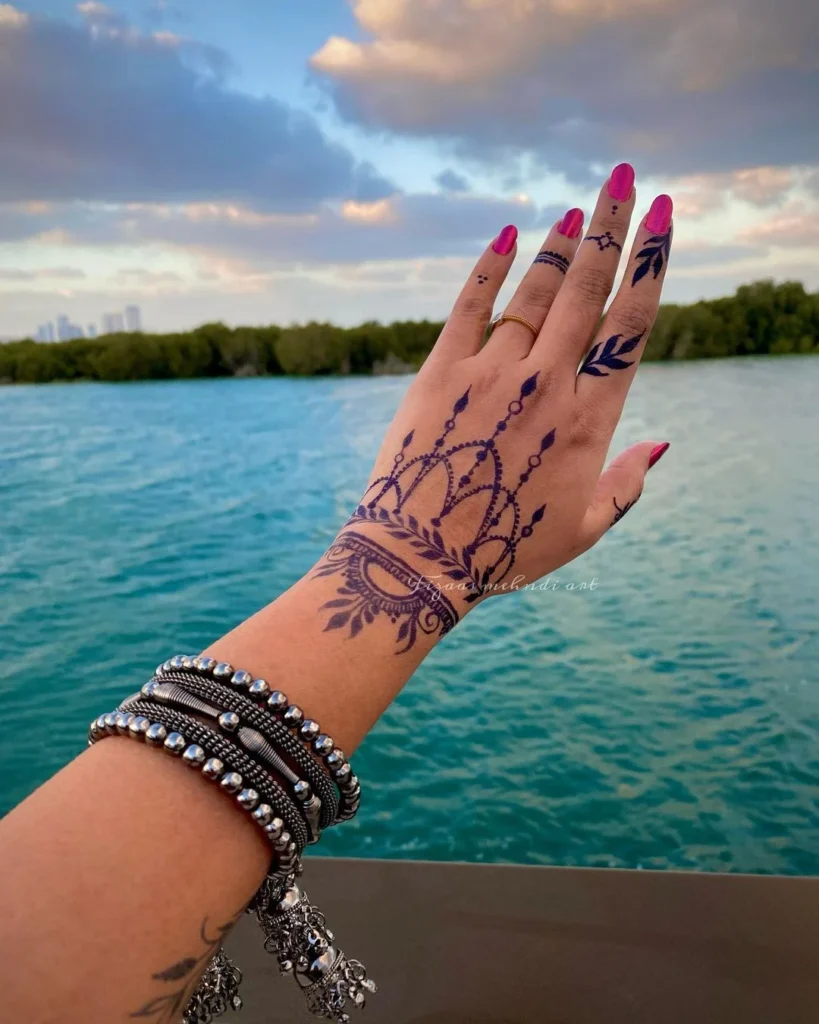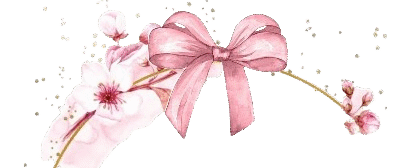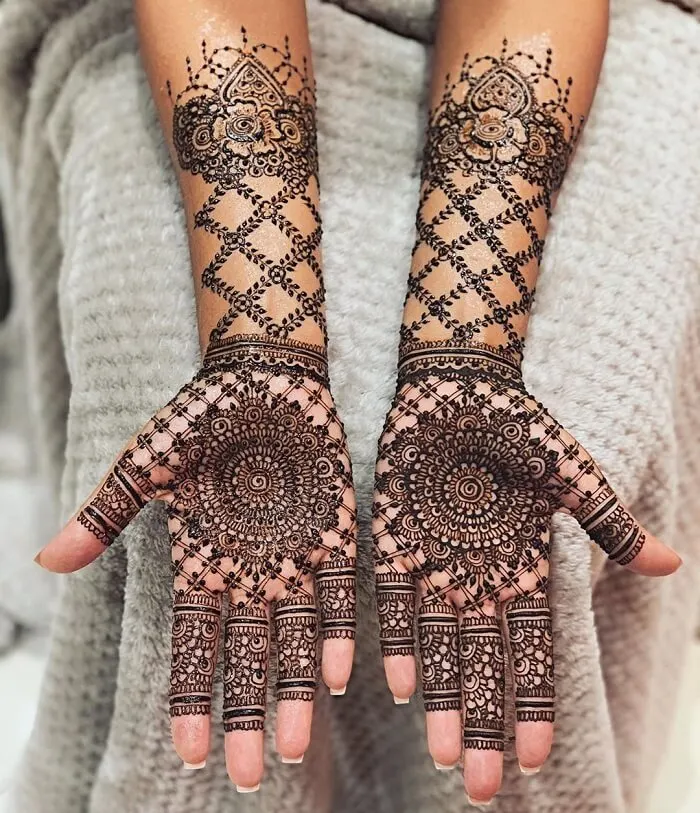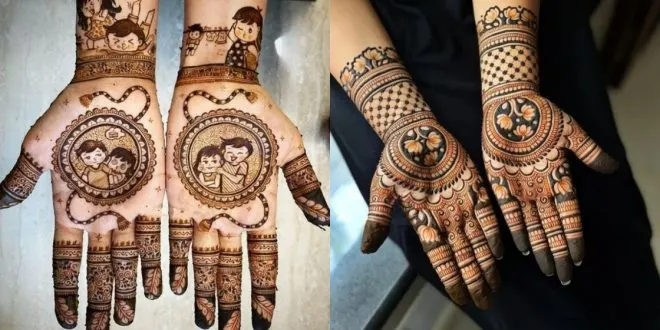Raksha Bandhan Mehndi Designs
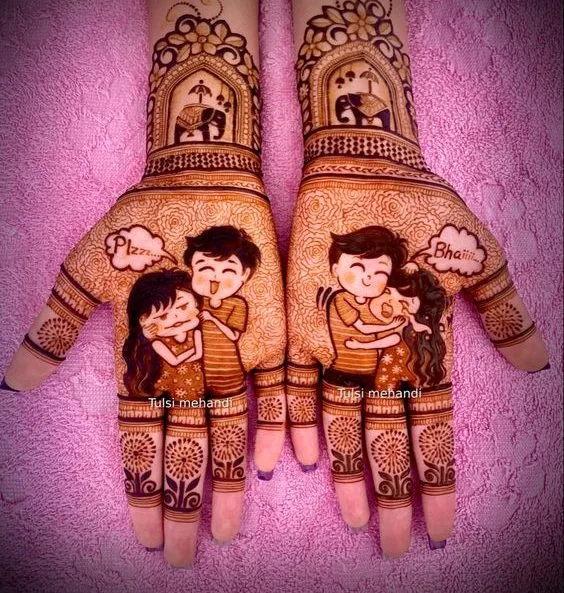
“रक्षा बंधन मेहंदी डिज़ाइन्स, रक्षा बंधन जिसे राखी के नाम से भी जाना जाता है, एक आनंदपूर्ण भारतीय त्योहार है जो भाई-बहन के बीच विशेष रिश्ते को मनाता है।”
Table of Contents
“राखी बांधने और उपहारों का आदान-प्रदान करना इस उत्सव के प्रमुख हिस्से हैं, लेकिन मेहंदी (हिना) लगाना भी कई महिलाओं और लड़कियों के लिए एक समान प्रिय परंपरा बन गई है। मेहंदी इस त्योहार में सुंदरता, लालित्य और सांस्कृतिक समृद्धि जोड़ती है, जिससे यह और भी अधिक उत्सवपूर्ण और यादगार बन जाता है। इस लेख में, हम राखी के दिन आपके हाथों को शानदार बनाने के लिए ट्रेंडिंग स्टाइल्स और पैटर्न्स से लेकर उपयोगी टिप्स और विचारों तक, राखी बंधन मेहंदी डिज़ाइन्स के बारे में सब कुछ जानेंगे।”
Raksha Bandhan Mehndi Designs for 2025
“2025 के लिए रक्षा बंधन मेहंदी डिज़ाइन्स परंपरा और आधुनिकता के मेल का सुंदर उदाहरण हैं। इस साल आप आकर्षक पैटर्न्स का शानदार मिश्रण देखेंगे—जटिल भारतीय फूलों से लेकर बोल्ड अरेबिक आउटलाइन और मिनिमलिस्ट डिज़ाइन्स तक, जो खासतौर पर युवा लड़कियों और कामकाजी महिलाओं के लिए परफेक्ट हैं। मेहंदी रक्षा बंधन के उत्सव में एक खास रंग भरती है, जो आपके त्योहार लुक को और भी मनमोहक बनाते हुए सांस्कृतिक परंपराओं का सम्मान करती है। चाहे आप आसान DIY डिज़ाइन्स ढूंढ रहे हों या ट्रेंडिंग इंस्टाग्राम-योग्य स्टाइल्स, 2025 हर उस बहन के लिए कुछ खास लेकर आया है जो अपने भाई के साथ प्यार और सुरक्षा के बंधन का जश्न मना रही है।”
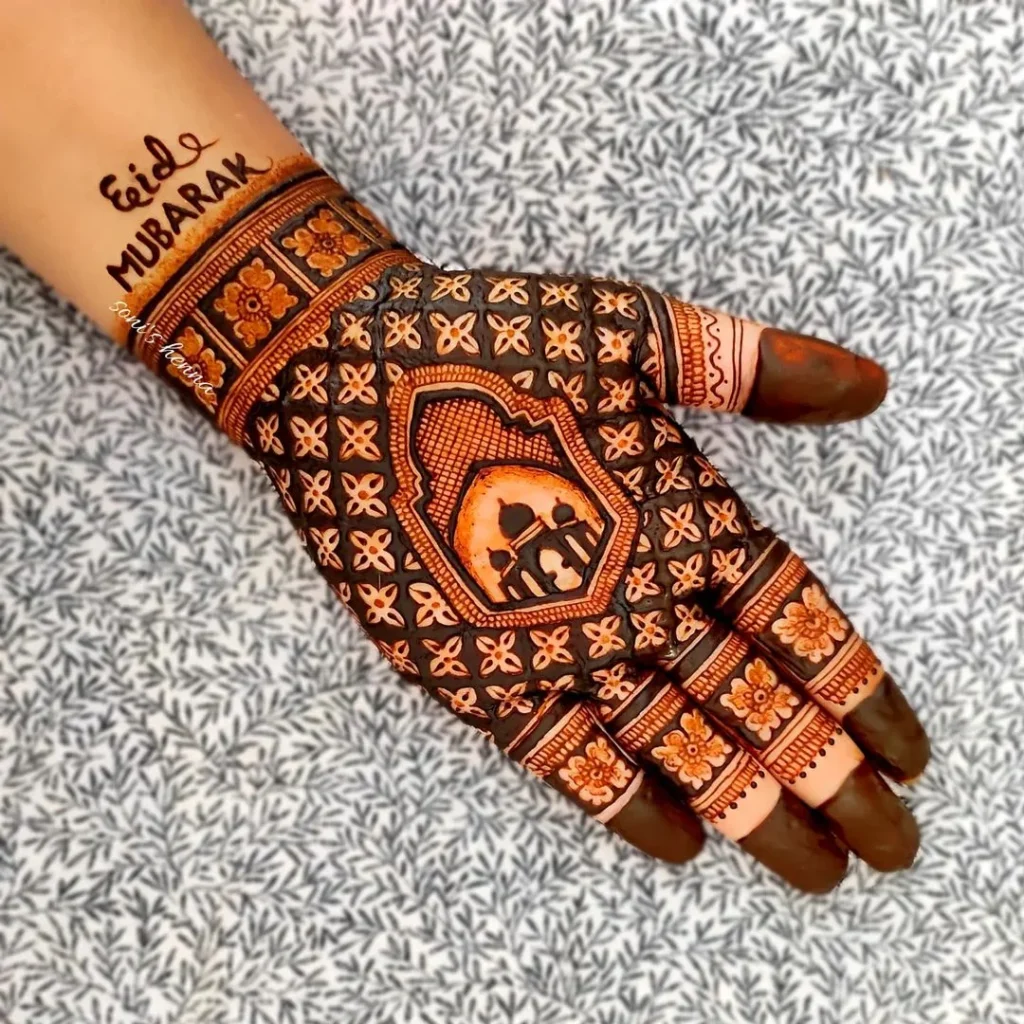
Top 50 Raksha Bandhan Mehndi Designs for Rakhi Celebrations
“रक्षा बंधन की भावना को स्टाइल में मनाएं हमारे द्वारा चुनी गई टॉप 50 रक्षा बंधन मेहंदी डिज़ाइन्स के साथ। पारंपरिक भारतीय मोटिफ्स से लेकर आधुनिक मिनिमलिस्ट पैटर्न्स तक, इस संग्रह में हर किसी के लिए कुछ न कुछ है—चाहे आप फ्लोरल एलिगेंस, अरेबिक कर्व्स, या राखी प्रेरित प्रतीकात्मक कला के फैन हों। मेहंदी न केवल आपके हाथों को सुंदरता प्रदान करती है, बल्कि यह आपकी राखी आउटफिट को भी उत्सवमयी रंग देती है। चाहे आप एक शुरुआत करने वाले हों या मेहंदी के शौकिन, ये शानदार डिज़ाइन्स इस दिल छूने वाले प्रेम और बंधन के त्योहार में आपको चमकने में मदद करेंगे।”
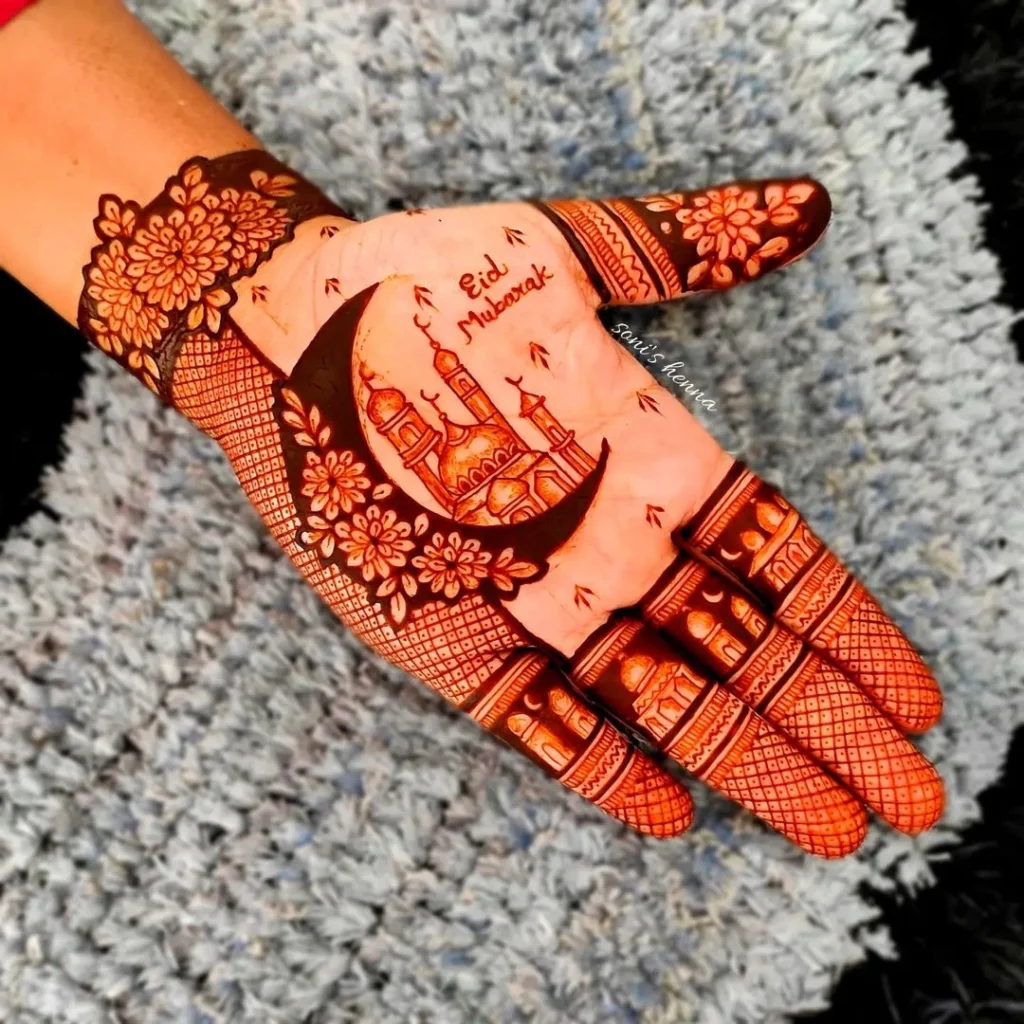
Latest Mehndi Trends for Rakhi Festival
“राखी महोत्सव केवल पवित्र धागा बांधने का नहीं है—यह स्टाइल, परंपरा और सुंदरता का उत्सव भी है। इस साल, राखी के लिए नवीनतम मेहंदी ट्रेंड्स पूरी तरह से रचनात्मकता और व्यक्तिगत अभिव्यक्ति पर केंद्रित हैं। शीक मिनिमलिस्ट पैटर्न्स और उंगलियों के टिप पर फ्लोरल डिज़ाइन्स से लेकर बोल्ड अरेबिक स्ट्रोक्स और भाई-बहन के प्रतीकात्मक डिज़ाइन्स तक, 2025 पारंपरिक हिना कला में एक नया ट्विस्ट लेकर आया है। चाहे आप सरल मोटिफ्स पसंद करते हों या पूरे हाथ की सुंदरता, ये ट्रेंडिंग मेहंदी स्टाइल्स आपके त्योहार लुक को बेहतरीन तरीके से पूरा करेंगे और रक्षा बंधन के जश्न में चार चांद लगा देंगे।”
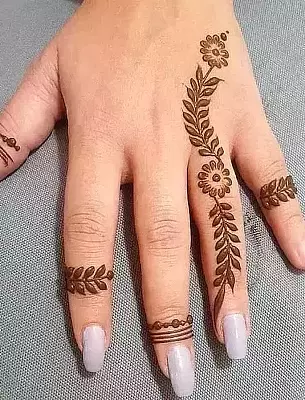
Why Mehndi is Important for Raksha Bandhan
“मेहंदी (हिना) रक्षा बंधन में एक विशेष भूमिका निभाती है और इसे इस त्योहार का अभिन्न हिस्सा माना जाता है। राखी जहाँ भाई-बहन के प्रेम और बंधन का प्रतीक है, वहीं मेहंदी इस अवसर को सांस्कृतिक, आध्यात्मिक और सौंदर्यपूर्ण रूप देती है। यहाँ जानिए रक्षा बंधन पर मेहंदी का महत्व क्यों है:
1. सांस्कृतिक महत्व
मेहंदी भारतीय परंपराओं में शुभता और समृद्धि का प्रतीक मानी जाती है। त्योहारों और शादियों में मेहंदी लगाना एक पुरानी प्रथा है, जो रक्षा बंधन पर भी बहनों के लिए बेहद खास होती है।
2. आध्यात्मिक और भावनात्मक पहलू
राखी के दिन मेहंदी लगाना न केवल सुंदरता बढ़ाता है, बल्कि यह बहनों के दिल में त्योहार के प्रति उत्साह और खुशी को भी गहरा करता है। माना जाता है कि मेहंदी की सुगंध और रंग सकारात्मक ऊर्जा और शुभता का संचार करते हैं।
3. सौंदर्य और उत्सव की चमक
त्योहार पर सजे-धजे हाथों में मेहंदी का रंग और भी आकर्षक दिखता है। चाहे सरल डिज़ाइन हों या जटिल पैटर्न, यह बहनों के लुक में खास चार्म जोड़ते हैं और पूरे माहौल को उत्सवपूर्ण बनाते हैं।
4. भाई-बहन के बंधन का प्रतीक
राखी की डोर की तरह मेहंदी भी रिश्तों की गहराई और परंपराओं से जुड़े रहने का प्रतीक है। मेहंदी लगाकर बहनें इस दिन को और यादगार और खूबसूरत बनाती हैं।
क्या आप चाहेंगे कि मैं इस हिस्से को SEO-फ्रेंडली हेडिंग्स और कीवर्ड्स के साथ लंबा आर्टिकल स्टाइल में लिख दूँ ताकि इसे ब्लॉग में सीधे इस्तेमाल किया जा सके?
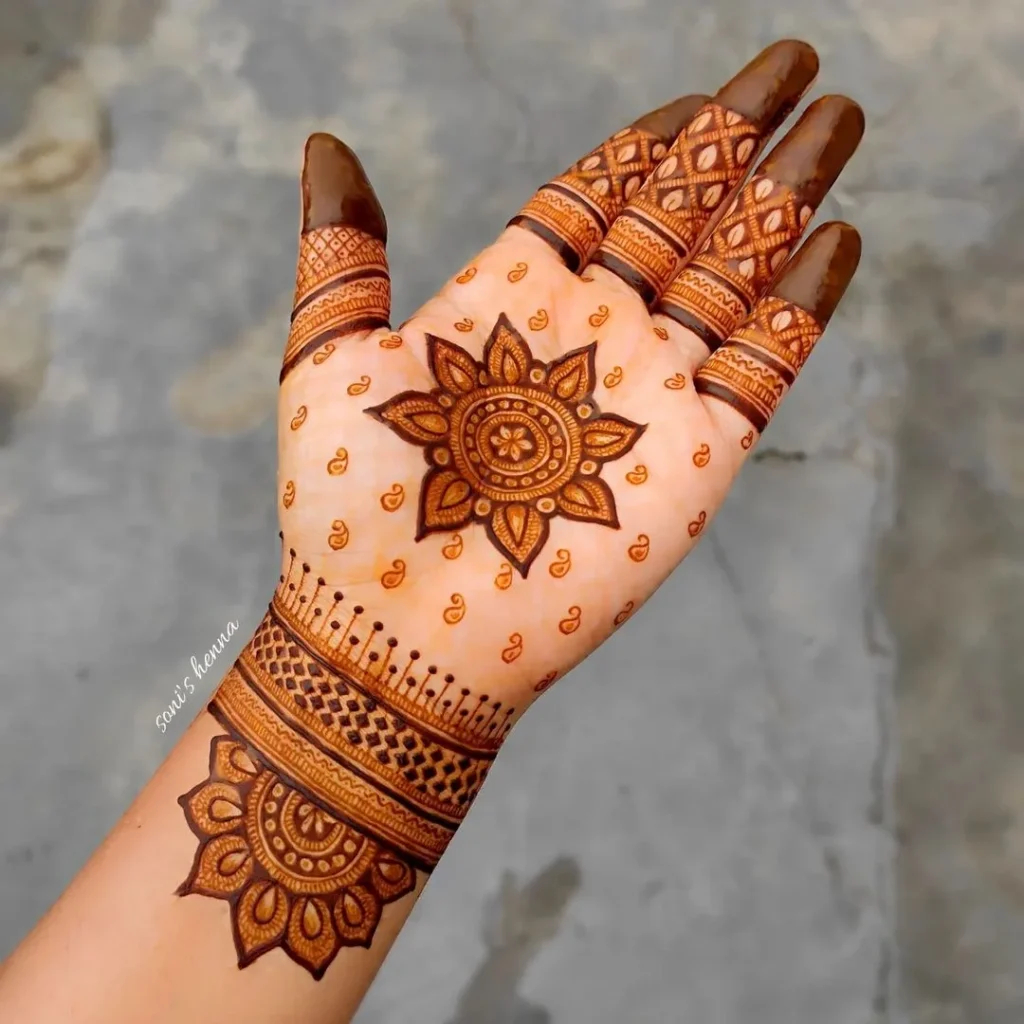
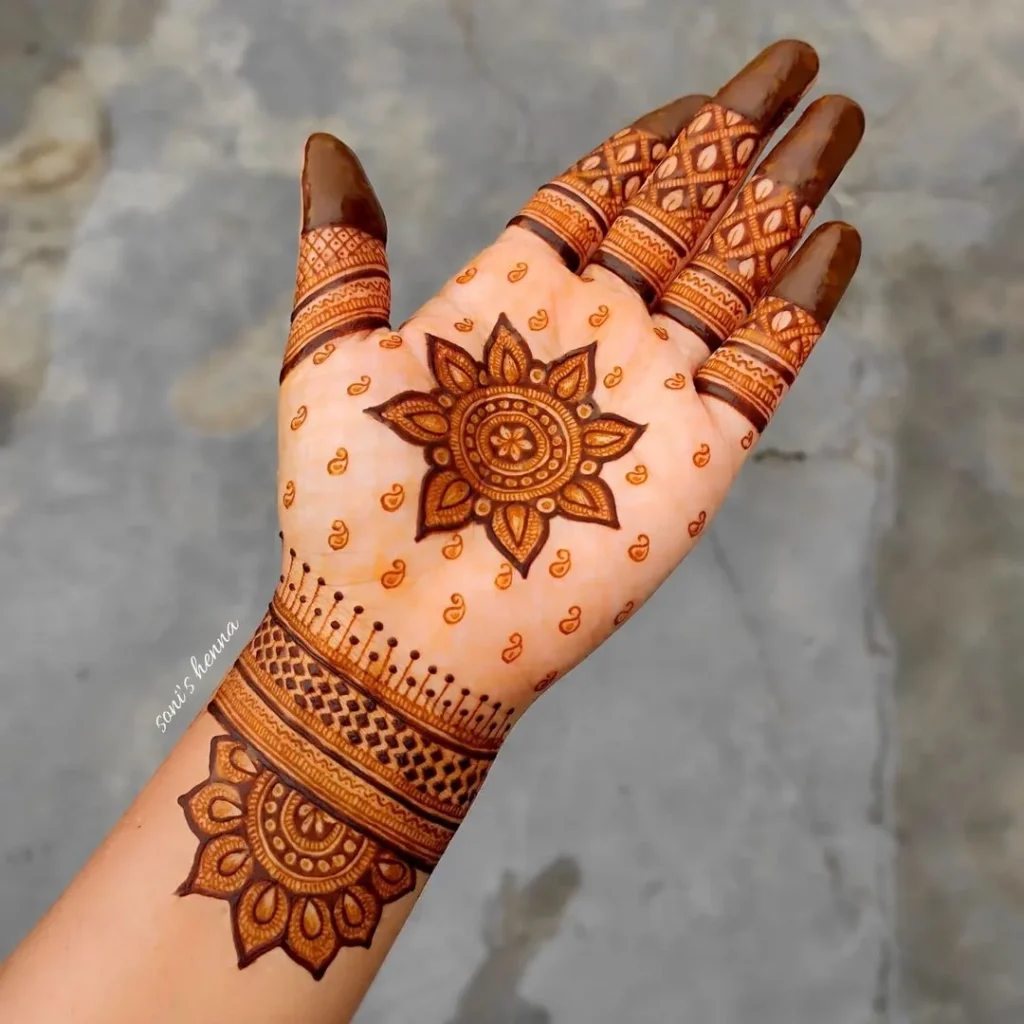
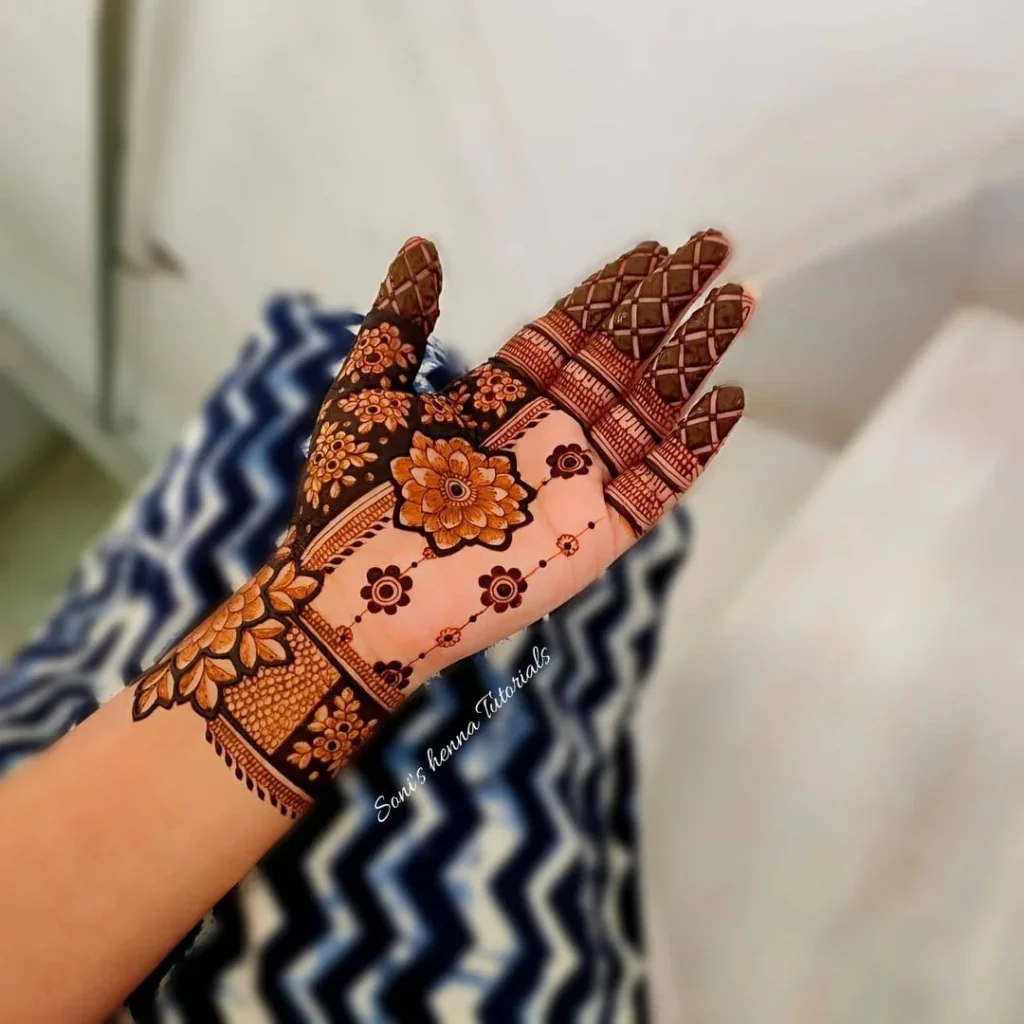
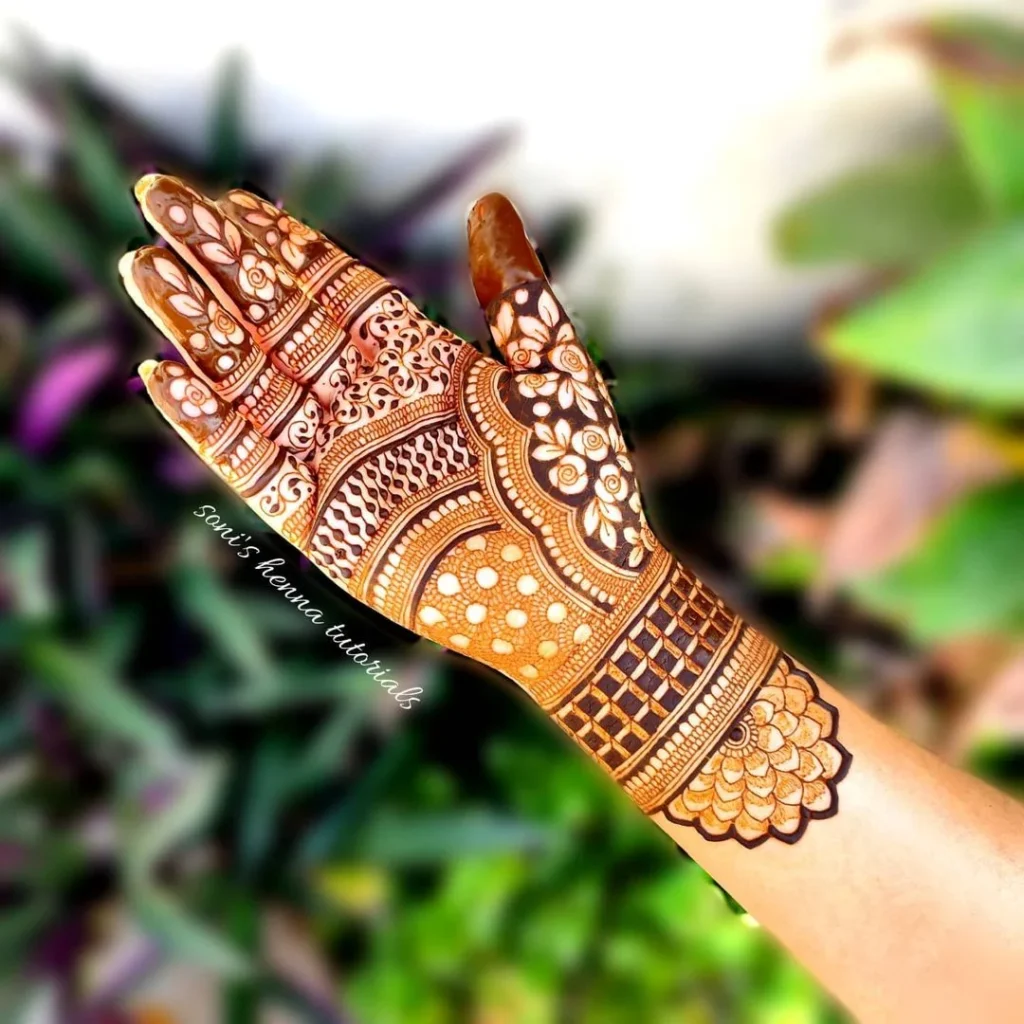
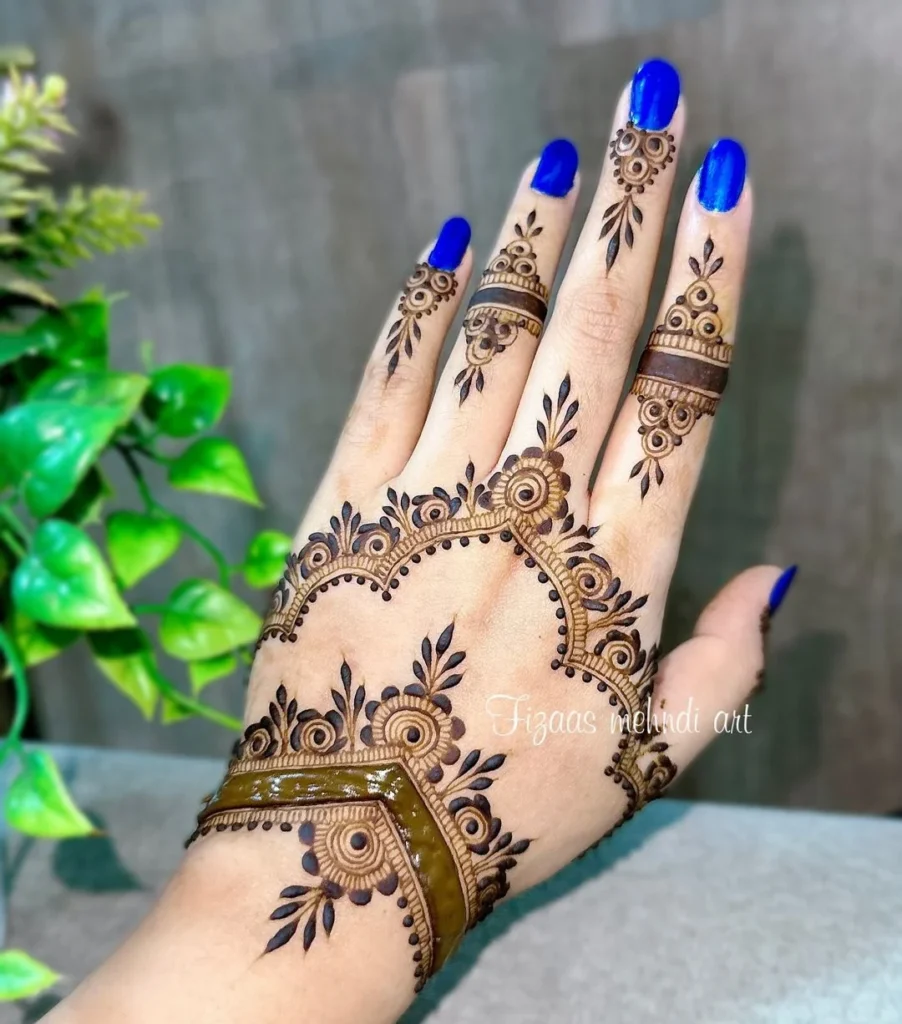
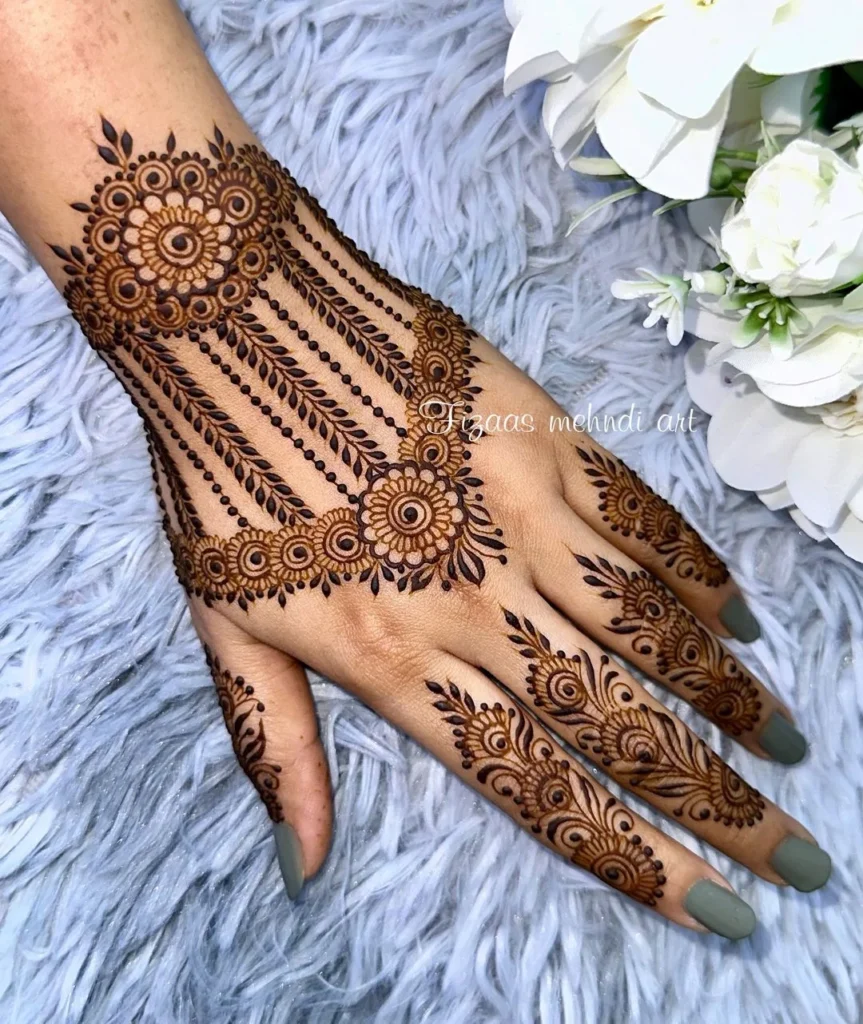
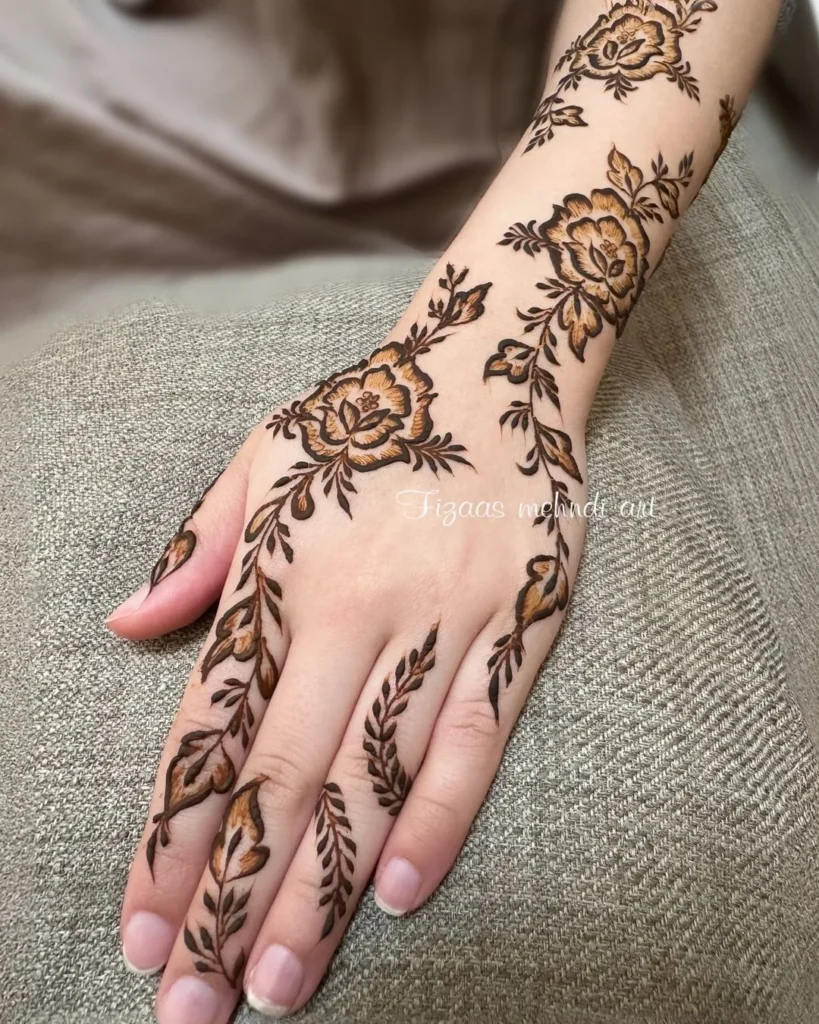
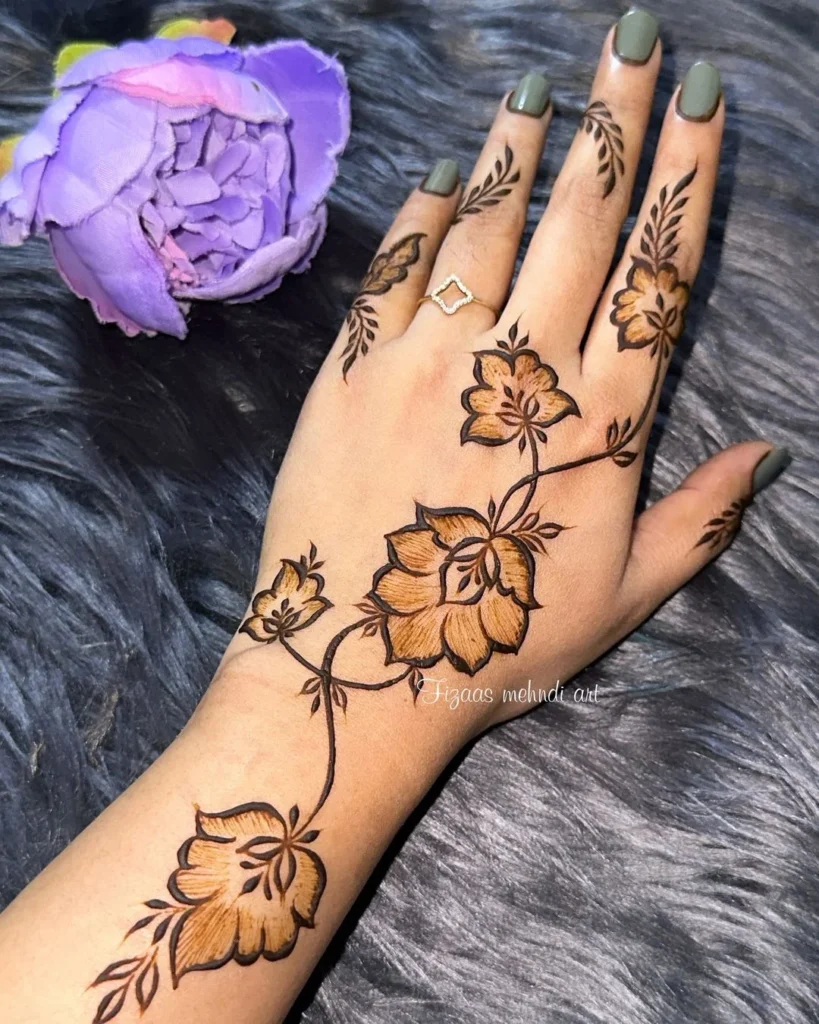
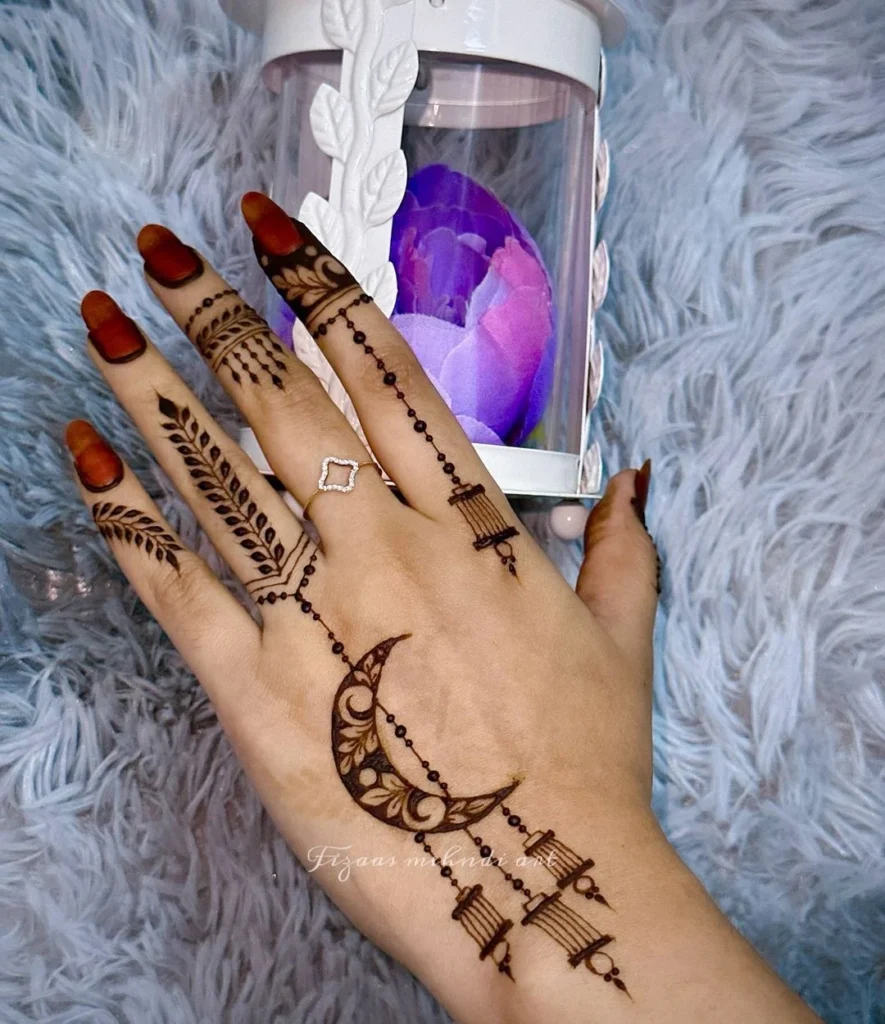
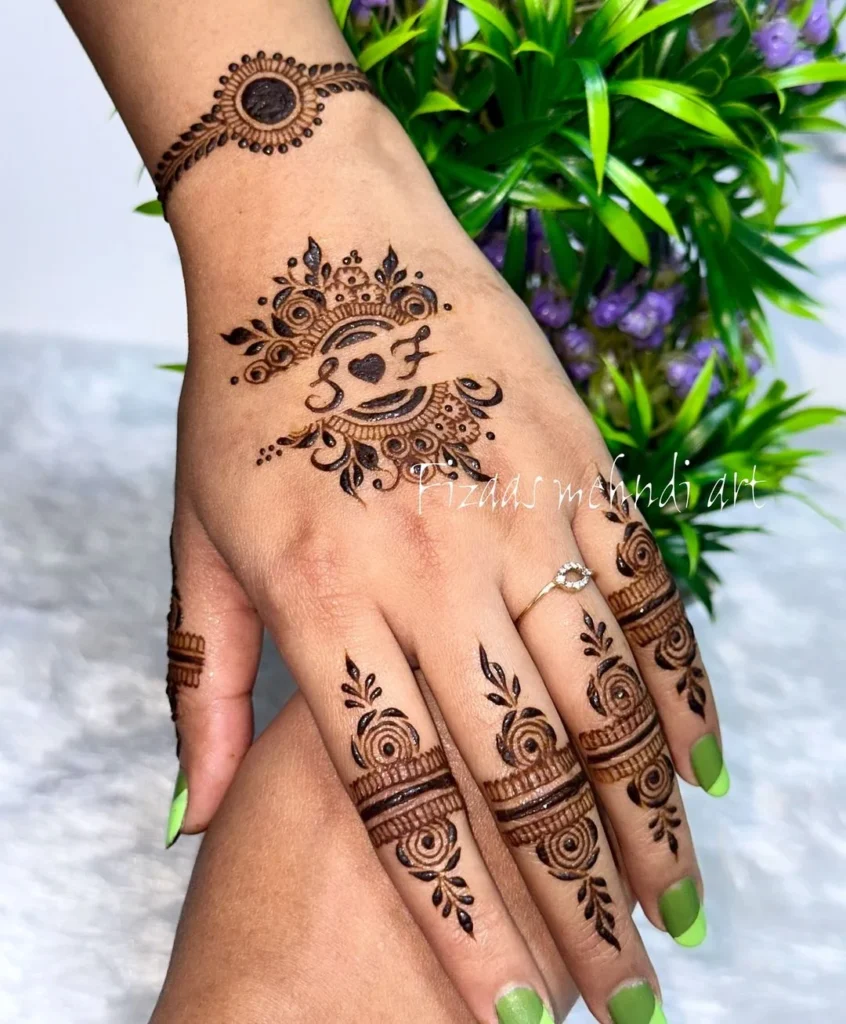
“मेहंदी रक्षा बंधन में एक अविभाज्य भूमिका निभाती है क्योंकि यह अनुष्ठान को और भी खास बनाती है, सांस्कृतिक गहराई जोड़ती है, और प्रेम और परंपरा की सुंदर अभिव्यक्ति के रूप में कार्य करती है। चाहे इसका प्रतीकात्मक महत्व हो, सौंदर्य की अपील हो, या भाई-बहन के रिश्ते को और मजबूती देने वाला अनुभव हो, मेहंदी इस त्योहार का एक अहम हिस्सा है जो रक्षा बंधन को और भी खास बनाती है।”
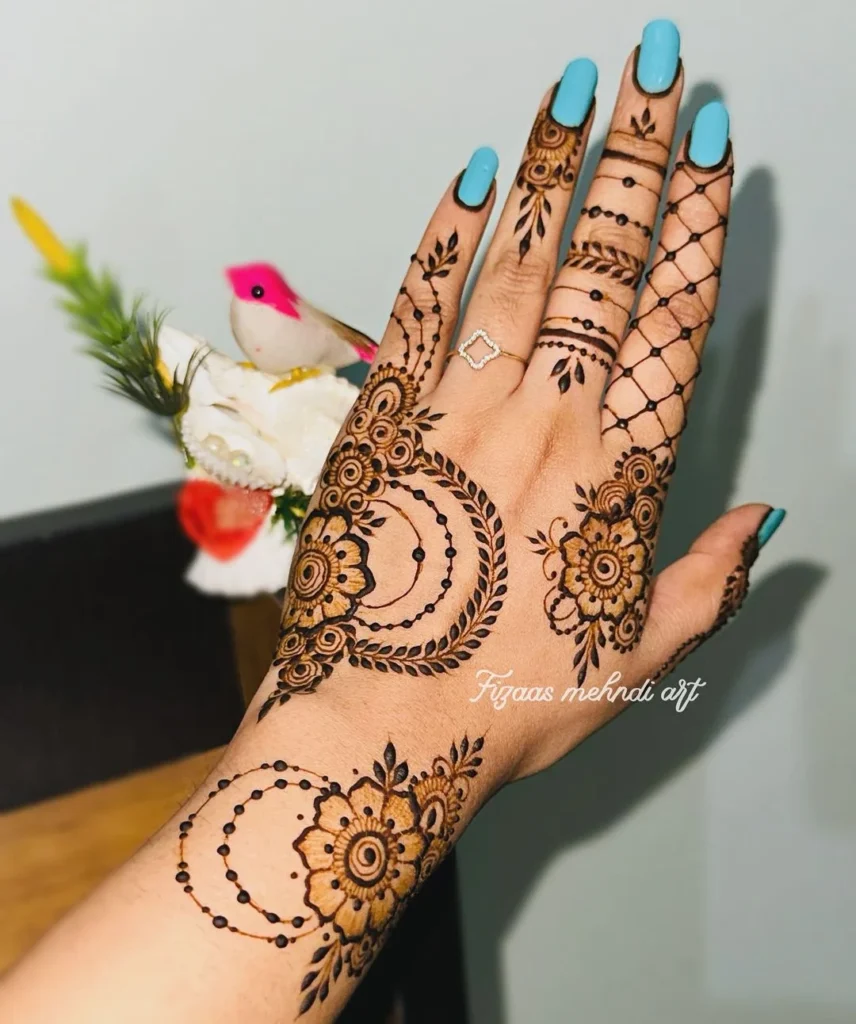
History of Applying Mehndi on Raksha Bandhan
रक्षा बंधन पर मेहंदी (हिना) लगाने का इतिहास दक्षिण एशिया की सांस्कृतिक और आध्यात्मिक परंपराओं से गहरे रूप से जुड़ा हुआ है, विशेषकर भारत में। जहां रक्षा बंधन का अपना अलग इतिहास है, वहीं इस त्योहार के दौरान मेहंदी का उपयोग प्रतीकात्मकता, सुंदरता और सांस्कृतिक गहराई का एक महत्वपूर्ण हिस्सा बनता है। रक्षा बंधन पर मेहंदी लगाने की परंपरा या रक्षा बंधन मेहंदी डिज़ाइन्स सदियों से विकसित होती रही है, और आइए हम इसके पीछे के इतिहास पर एक नज़र डालते हैं।:
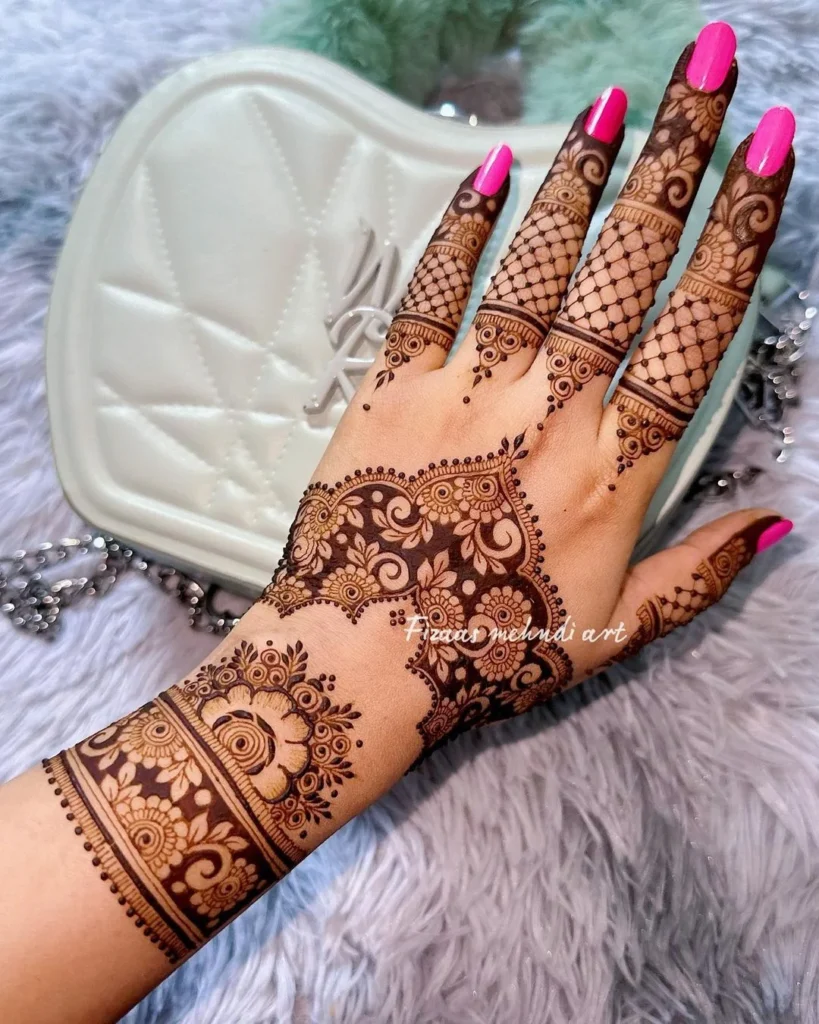
1. Ancient Use of Mehndi in India
- “मेहंदी का उपयोग 5,000 साल से भी पहले प्राचीन मिस्र और भारत में शुरू हुआ था। मेहंदी, जो हिना पौधे की पत्तियों से बनाई जाती है, इसके ठंडक देने और औषधीय गुणों के लिए जानी जाती थी, साथ ही इसे सौंदर्य उद्देश्यों के लिए भी इस्तेमाल किया जाता था। इसे चिकित्सा गुणों के लिए माना जाता था, और इसका उपयोग विभिन्न समारोहों, जैसे कि शादियों और त्योहारों, से जुड़ा हुआ था।
- भारत में, मेहंदी को सदियों से महत्वपूर्ण जीवन घटनाओं, जैसे कि शादियों, त्योहारों और संस्कारों का हिस्सा के रूप में इस्तेमाल किया जाता था। समय के साथ, यह भारतीय संस्कृति का अभिन्न हिस्सा बन गया, खासकर प्रमुख त्योहारों जैसे दीवाली, करवा चौथ, और रक्षा बंधन के दौरान।”
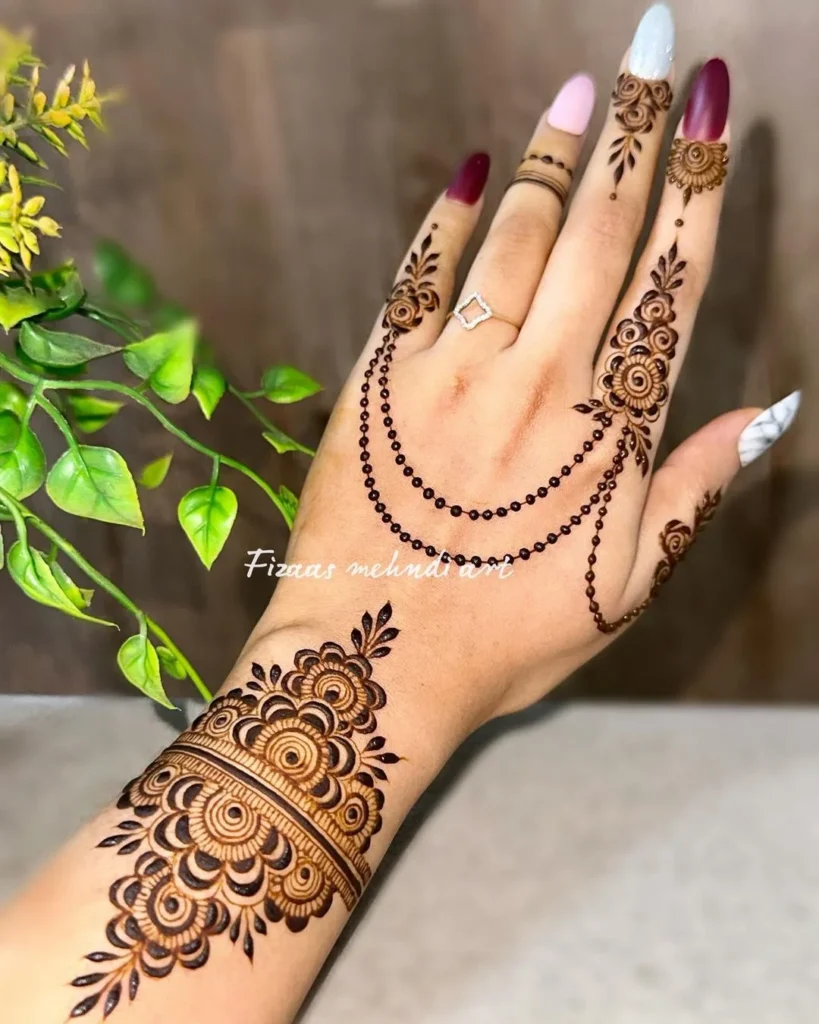
2. The Tradition of Raksha Bandhan
- “रक्षा बंधन, जो भाई-बहन के रिश्ते का उत्सव है, प्राचीन भारत में अपनी जड़ें रखता है। हालांकि इस त्योहार की सटीक उत्पत्ति पर बहस है, एक प्रसिद्ध पौराणिक कथा इसे राजा बलि और देवी लक्ष्मी के संदर्भ से जोड़ती है। एक अन्य कथा महाभारत से है, जहां द्रौपदी ने भगवान कृष्ण के हाथ पर एक पवित्र धागा (राखी) बांधा था, और उन्होंने उसे अपनी सुरक्षा का वादा किया।
- समय के साथ, राखी बांधने की परंपरा एक प्रिय रिवाज में बदल गई, जिसमें बहनें अपने भाई के कलाई पर राखी बांधती थीं, उसकी भलाई और सुरक्षा के लिए प्रार्थना करती थीं। इसके बदले, भाई उपहार देते और अपनी बहनों की रक्षा करने का वादा करते।”
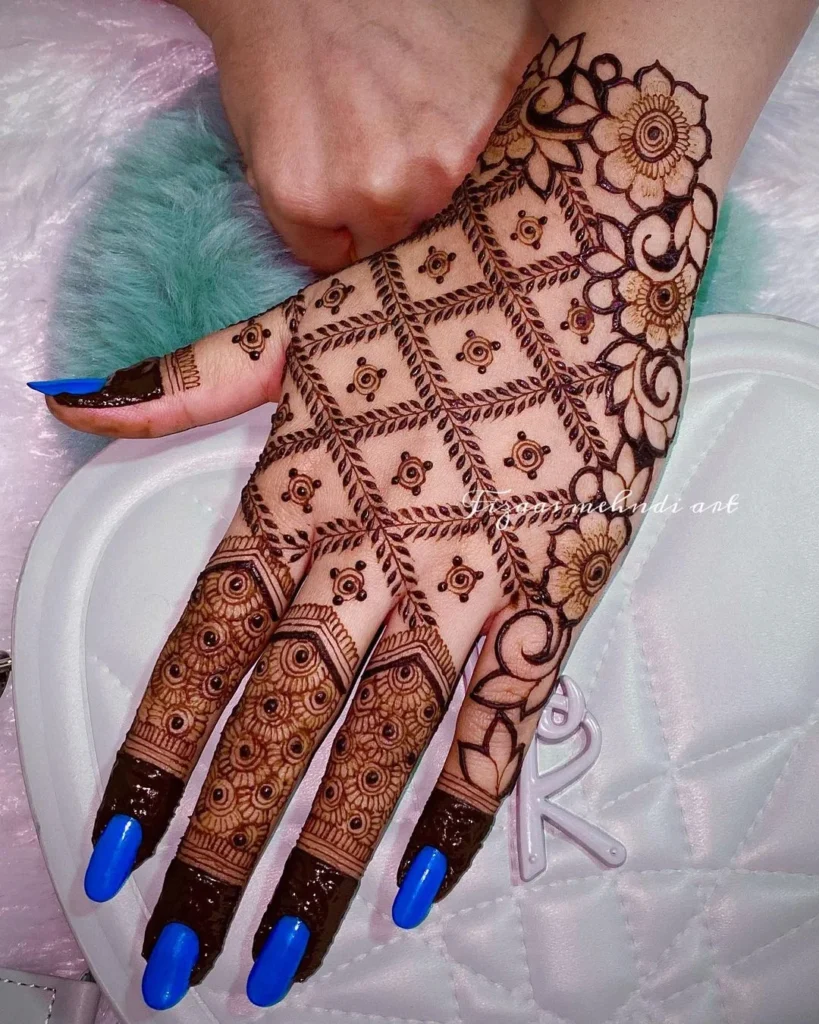
3. Incorporating Mehndi in Raksha Bandhan
- “रक्षा बंधन के दौरान मेहंदी लगाने की परंपरा संभवतः भारत में त्योहारों और उत्सवों की व्यापक सांस्कृतिक और आध्यात्मिक प्रथाओं का हिस्सा के रूप में विकसित हुई। जहां राखी बांधना त्योहार का केंद्रीय क्रिया बन गया, वहीं मेहंदी लगाना इस दिन की तैयारी और इस अवसर के लिए खुद को सुंदर बनाने का एक तरीका बन गया।
- मेहंदी, जो पारंपरिक रूप से शादियों के समारोहों में दुल्हन को लगाई जाती थी, रक्षा बंधन जैसे त्योहारों में एक प्रतीकात्मक जोड़ बन गई क्योंकि इसे पहनने वाले के लिए आशीर्वाद माना जाता था। जटिल डिज़ाइन्स को शुभ माना जाता था और ये सुंदरता, समृद्धि और सुरक्षा का प्रतीक होते थे। हाथों और पैरों पर मेहंदी लगाने का कार्य भाग्य और समृद्धि लाने का विश्वास था, जो रक्षा बंधन की भावना से मेल खाता है, जहां मुख्य विषय सुरक्षा और भलाई है।”
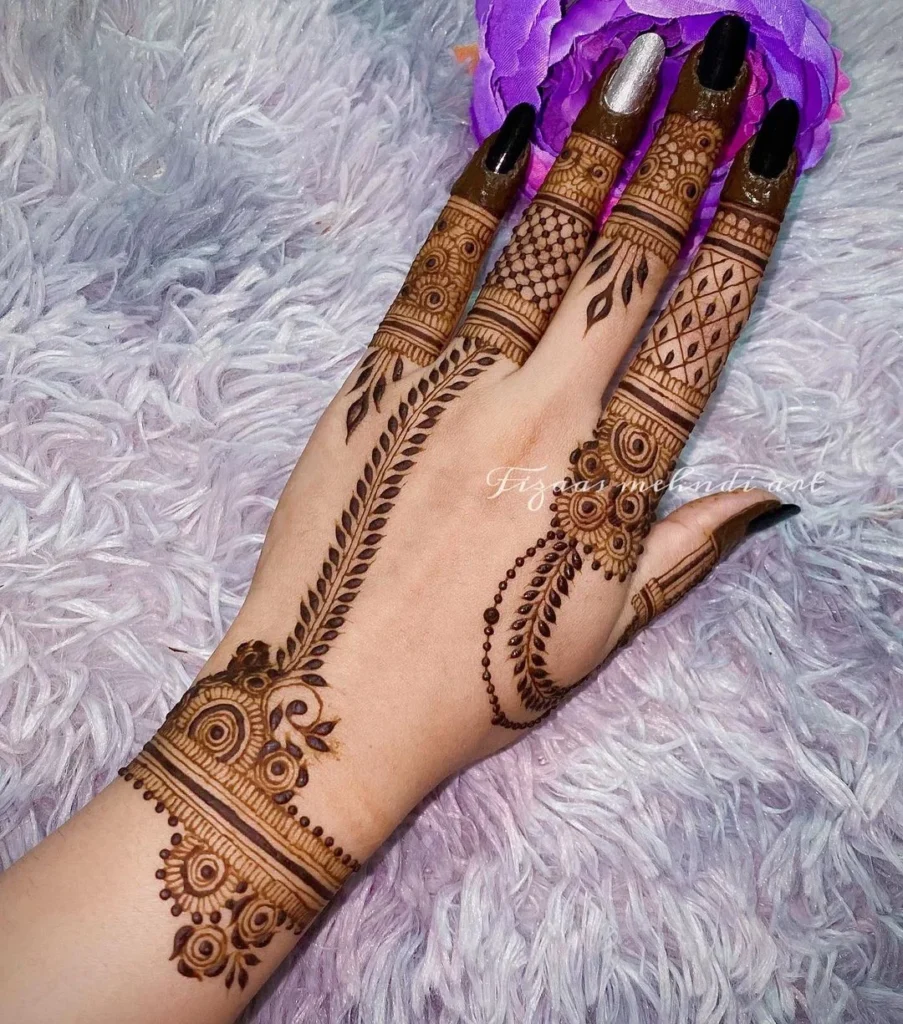
4. Cultural Significance of Mehndi
- “समय के साथ, मेहंदी न केवल शादियों का हिस्सा बनी बल्कि भारत में विभिन्न त्योहारों का भी अभिन्न हिस्सा बन गई। रक्षा बंधन के दौरान, इसका प्रतीकात्मक महत्व और भी गहरा हो गया। मेहंदी के रंग को भाई-बहन के रिश्ते की मजबूती का प्रतीक माना जाता था: गहरा रंग मजबूत और स्थायी रिश्ते को दर्शाता था।
- मेहंदी के जटिल पैटर्न, जो अक्सर फ्लोरल मोटिफ्स, पेस्ली और ज्यामितीय डिज़ाइन्स से बने होते थे, भाई-बहन के बीच की जटिल और कीमती बंधन को दर्शाने के रूप में देखे जाते थे। जैसे-जैसे रक्षा बंधन भारत में व्यापक रूप से मनाया जाने लगा, वैसे-वैसे त्योहार के दौरान मेहंदी लगाने की परंपरा भी उन परिवारों द्वारा अपनाई गई, जो उत्सव को सुंदरता और सांस्कृतिक महत्व से बढ़ाना चाहते थे।”
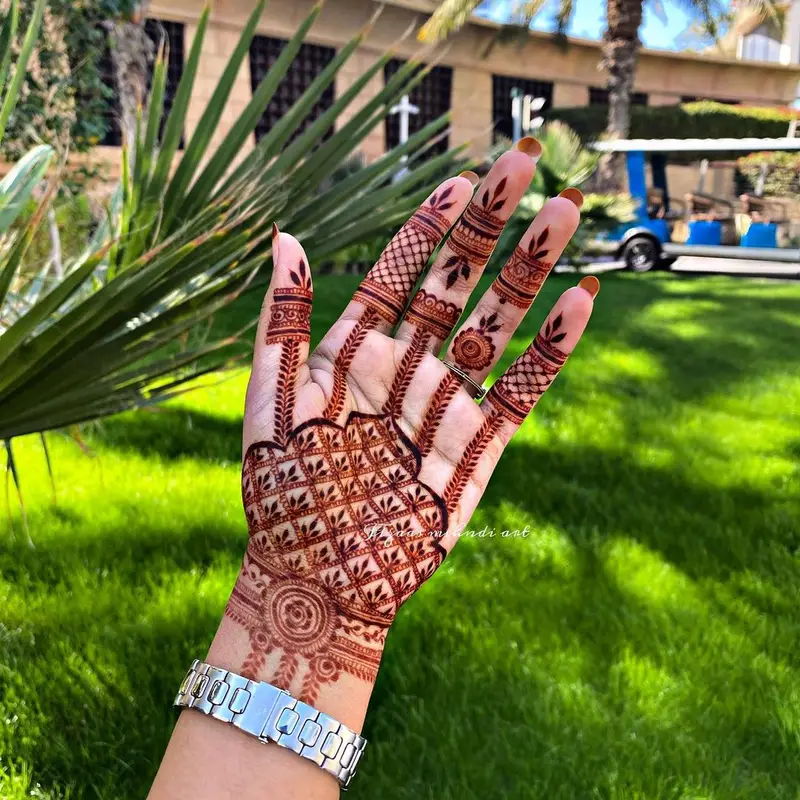
5. Modern Evolution of Raksha Bandhan Mehndi designs
- 20वीं शताब्दी में, आधुनिक कला के उदय के साथ, राखी बंधन की मेहंदी डिज़ाइनें अधिक विस्तृत और कलात्मक हो गईं। जटिल मेहंदी डिज़ाइनें, जैसे मंडला, मोर के पंख और पुष्प पैटर्न, पारंपरिक राखी बंधन उत्सव का हिस्सा बनने लगीं। ये डिज़ाइनें केवल प्रतीकात्मक ही नहीं थीं, बल्कि आत्म-अभिव्यक्ति का एक महत्वपूर्ण साधन भी बन गईं।
- मेहंदी के व्यवसायीकरण ने रेडी-टू-यूज़ हिना कोन के विकास को जन्म दिया, जिससे लोगों के लिए घर पर ही मेहंदी लगाना आसान हो गया। इसके साथ ही, राखी बंधन पर मेहंदी लगाने की परंपरा और अधिक फैल गई, जिससे वे लोग भी इस अनुष्ठान में भाग ले सके जिनके पास पेशेवर मेहंदी कलाकारों की सुविधा नहीं थी।
- सोशल मीडिया ने मेहंदी कला को आधुनिक बनाने में एक प्रमुख भूमिका निभाई है। इंस्टाग्राम और पिंटरेस्ट जैसे प्लेटफ़ॉर्म पर मेहंदी डिज़ाइनों के नवीनतम रुझानों को प्रदर्शित करने से युवा पीढ़ी ने राखी बंधन पर मेहंदी को व्यक्तिगत शैली और फैशन के रूप में अपनाया है।
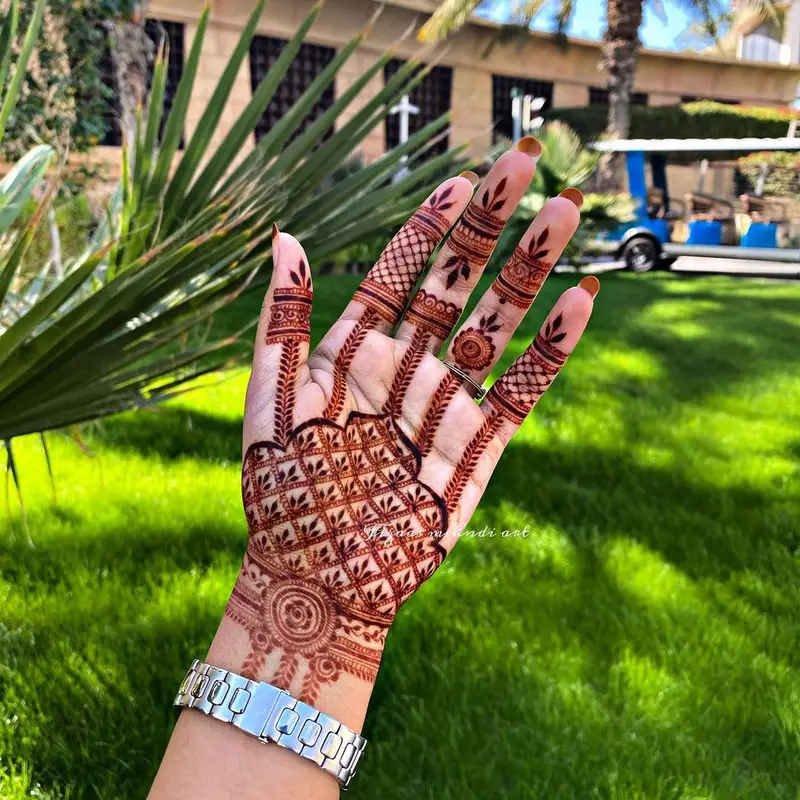
6. Connection Between Rakhi and Mehndi
- रक्षाबंधन पर मेहंदी का उपयोग केवल सजावटी तत्व नहीं है, बल्कि यह एक धार्मिक परंपरा भी है। हाथों और पैरों पर मेहंदी सजाने की क्रिया राखी समारोह की तैयारी का एक महत्वपूर्ण हिस्सा मानी जाती है। ऐसा विश्वास है कि जितनी अधिक बारीक और सुंदर मेहंदी होगी, बहन को उतनी ही अधिक आशीर्वाद प्राप्त होंगे।
- मेहंदी बहन के स्नेह का भी प्रतीक है। जब बहन अपने हाथों पर मेहंदी लगाती है, तो यह अपने भाई के प्रति उसके प्रेम और देखभाल की अभिव्यक्ति होती है, जो इस त्योहार में भावनात्मक महत्व जोड़ती है। मेहंदी लगाने की परंपरा परिवारों में एक जुड़ाव का अवसर बन गई है, जहाँ बहनें और महिला रिश्तेदार मिलकर राखी समारोह की तैयारी में अपने हाथ सजाती हैं।
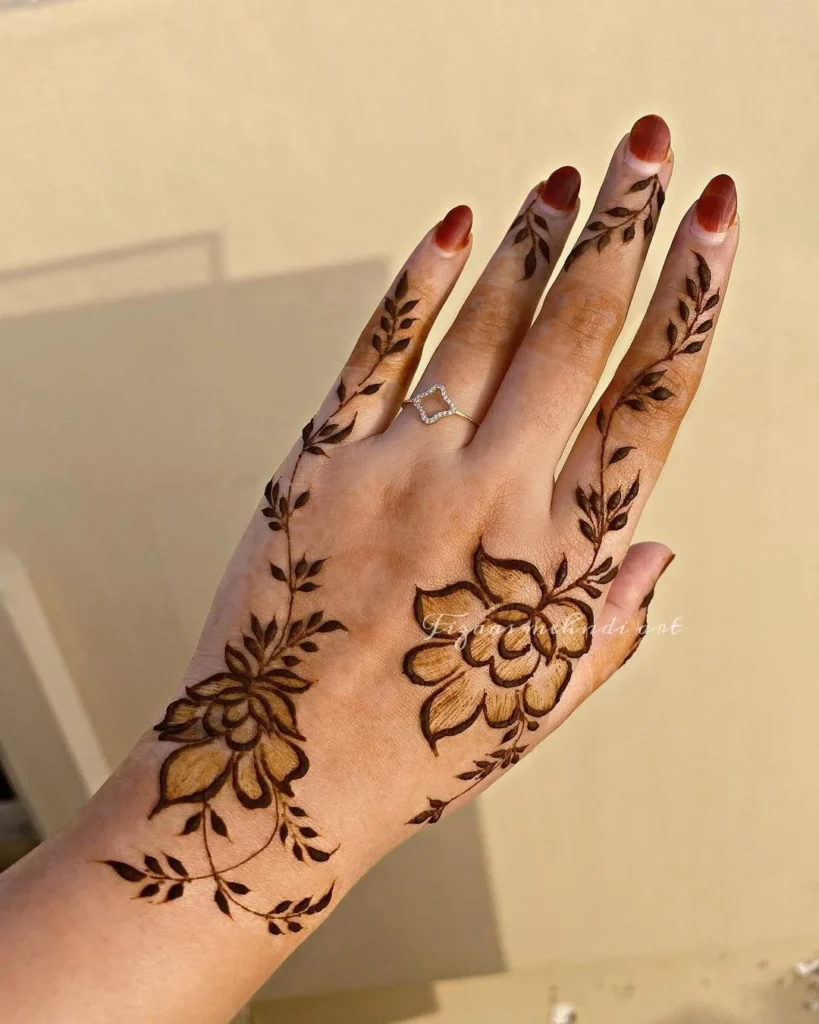
7. Cultural Continuity
- रक्षाबंधन पर मेहंदी लगाने की परंपरा पीढ़ी दर पीढ़ी चली आ रही है। त्योहार के वैश्वीकरण के बावजूद, मेहंदी की यह परंपरा भारतीय प्रवासी समुदायों के उत्सवों का एक महत्वपूर्ण हिस्सा बनी हुई है। संयुक्त राज्य अमेरिका, कनाडा और यूनाइटेड किंगडम जैसे देशों में, जहाँ बड़ी भारतीय आबादी रहती है, रक्षाबंधन पर मेहंदी लगाने की प्रथा उन लोगों द्वारा अपनाई गई है जो अपनी सांस्कृतिक जड़ों से जुड़े रहना चाहते हैं।
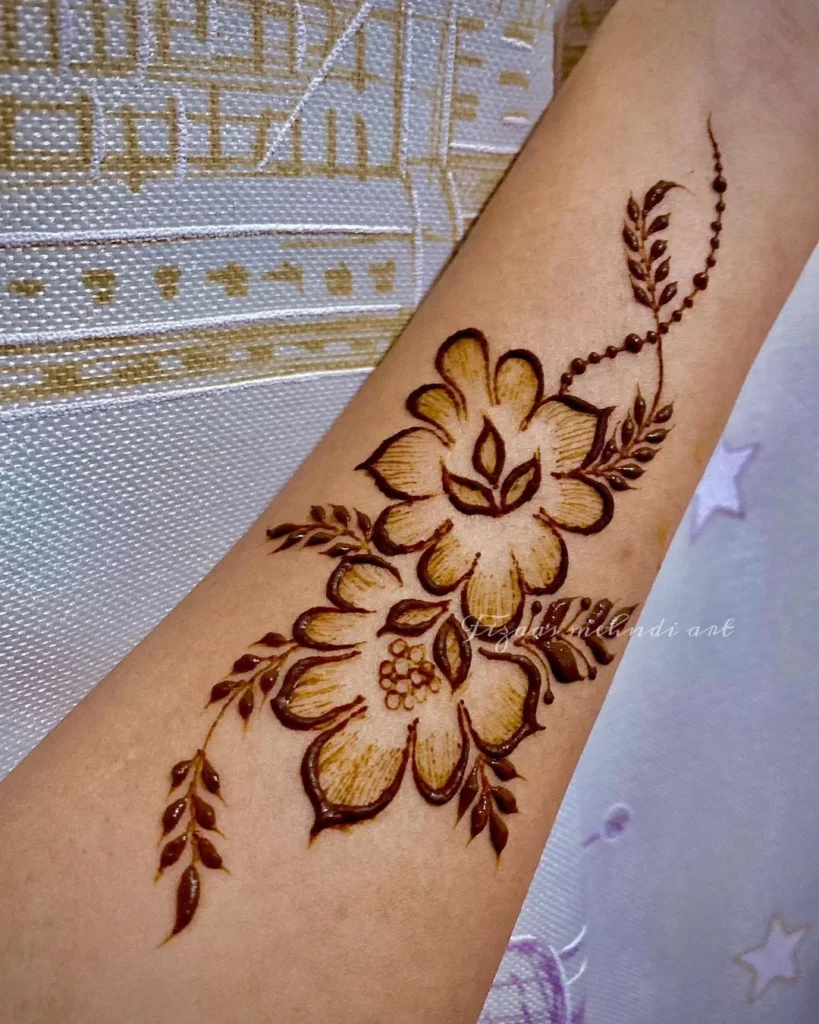
रक्षाबंधन पर मेहंदी डिज़ाइन लगाने की परंपरा सदियों में एक साधारण सौंदर्य और धार्मिक क्रिया से विकसित होकर एक प्रिय सांस्कृतिक परंपरा बन गई है। प्राचीन रीति-रिवाजों में निहित, मेहंदी सौभाग्य, सुरक्षा और प्रेम का प्रतीक मानी जाती है, जो रक्षाबंधन के मूल्यों से पूरी तरह मेल खाती है। समय के साथ, मेहंदी राखी उत्सव का एक महत्वपूर्ण हिस्सा बन गई है, जो इस त्योहार में सुंदरता, सांस्कृतिक गहराई और भावनात्मक महत्व जोड़ती है। आज भी, यह रक्षाबंधन के उत्सव का अभिन्न अंग है, जो परिवारों को भाई-बहन के अटूट बंधन का जश्न मनाने के लिए एक साथ लाती है।
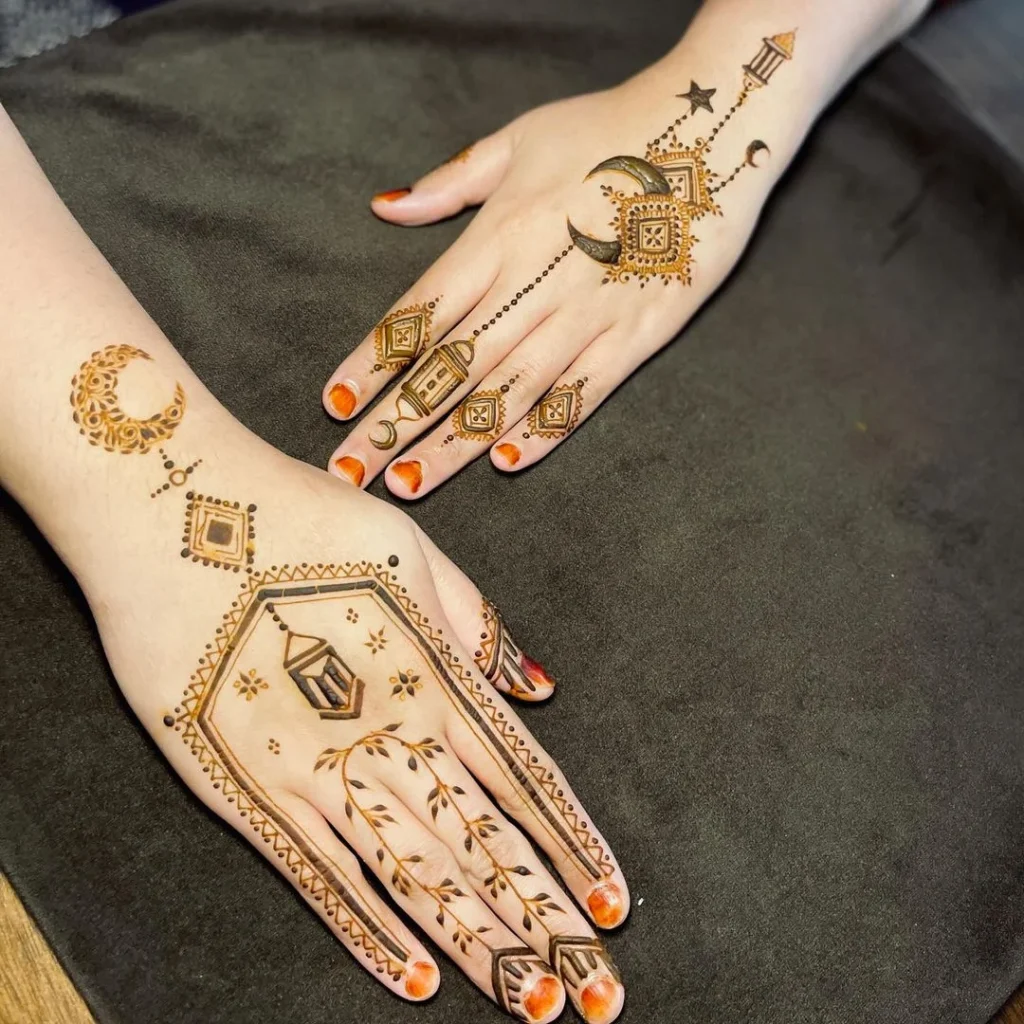
Complete Guide to Raksha Bandhan Mehndi Designs
रक्षाबंधन, भाई-बहन के पवित्र रिश्ते का जश्न मनाने वाला सुंदर त्योहार, मेहंदी की जटिल कला के बिना अधूरा है। मेहंदी लगाने की परंपरा इस उत्सव में रंग, सुंदरता और खुशियाँ जोड़ती है। यहाँ हम रक्षाबंधन मेहंदी डिज़ाइनों की पूरी जानकारी दे रहे हैं, जिसमें विचार, सुझाव और तकनीकें शामिल हैं, जो आपको इस खास अवसर के लिए परफेक्ट डिज़ाइन चुनने में मदद करेंगी।
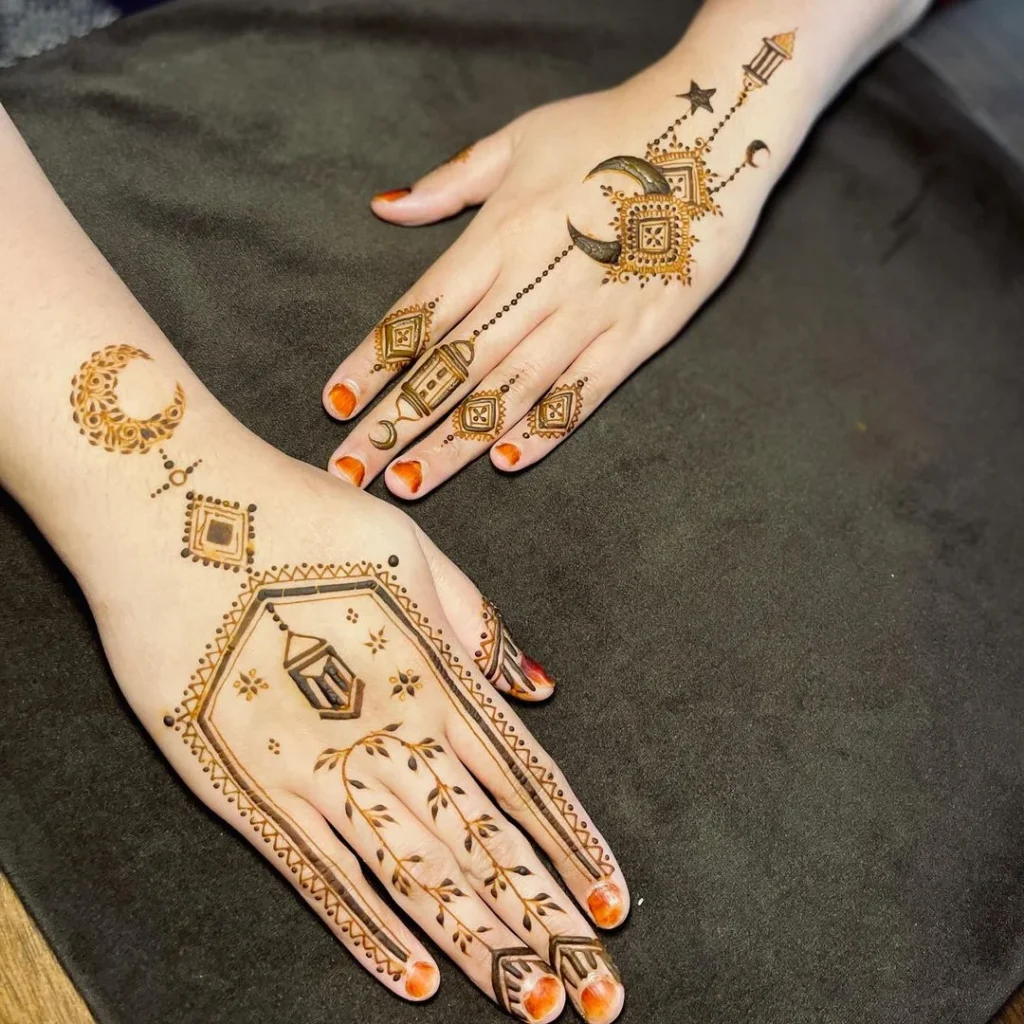
1. Understanding the Significance of Mehndi in Raksha Bandhan
मेहंदी का सांस्कृतिक और आध्यात्मिक महत्व बहुत गहरा है, खासकर रक्षाबंधन जैसे त्योहारों में। यह समृद्धि, खुशी और सुरक्षा का प्रतीक मानी जाती है। माना जाता है कि जितना गहरा मेहंदी का रंग होता है, भाई-बहन का रिश्ता उतना ही मजबूत होता है। मेहंदी लगाने की क्रिया को रिश्ते में सकारात्मक ऊर्जा और आशीर्वाद लाने का एक माध्यम भी माना जाता है।
2. Types of Raksha Bandhan Mehndi Designs
रक्षाबंधन के लिए मेहंदी डिज़ाइनों के कई प्रकार उपलब्ध हैं, जिनमें से कोई भी अपनी पसंद और चाही गई सुंदरता के अनुसार चुना जा सकता है। हर डिज़ाइन की अपनी एक अलग खूबसूरती होती है, इसलिए सही चुनाव पूरी तरह व्यक्तिगत पसंद और शैली पर निर्भर करता है। यहाँ कुछ लोकप्रिय विकल्प दिए गए हैं:
a. Traditional Indian Designs
- फ्लोरल मोटिफ़ (फूलों के डिज़ाइन): फूल सुंदरता और जीवन का प्रतीक होते हैं, इसलिए राखी मेहंदी में इन्हें अक्सर चुना जाता है। कमल, गुलाब और चेरी जैसे फूलों के डिज़ाइन जटिल पैटर्न में देखने को मिलते हैं।
- पैसली (अंबराई डिज़ाइन): पैसली डिज़ाइन, जो बूंद के आकार जैसा दिखता है, मेहंदी में बहुत प्रयोग होता है। यह उर्वरता, समृद्धि और शुभता का प्रतीक है।
- मंडला पैटर्न: मंडला गोलाकार डिज़ाइन होते हैं, जो सामंजस्य और एकता का प्रतीक हैं। इनकी जटिल ज्यामिति आपके राखी मेहंदी डिज़ाइन में सुंदरता जोड़ सकती है।
- मोर के डिज़ाइन: भारतीय संस्कृति में मोर सुंदरता और शालीनता का प्रतीक है। इसके पंख अक्सर मेहंदी डिज़ाइनों में शामिल किए जाते हैं, जिससे बेहद आकर्षक और बारीक कलाकृति बनती है।
b. Contemporary Mehndi Designs
- ज्यामितीय पैटर्न: इन आधुनिक डिज़ाइनों में चौकोर, हीरे और अन्य आकृतियाँ शामिल होती हैं, जिन्हें संतुलित ढंग से सजाया जाता है। ये हाथों को एक साधारण लेकिन आकर्षक रूप प्रदान करते हैं।
- एब्सट्रैक्ट डिज़ाइन: इनमें स्वतंत्र रूप से बहने वाली रेखाएँ, घुमाव और बिंदु शामिल होते हैं, जो एक अनोखी और कलात्मक शैली पेश करते हैं और भीड़ से अलग दिखते हैं।
- बोल्ड लाइन्स और पैटर्न: आधुनिक मेहंदी डिज़ाइनों में अक्सर गहरी और मोटी रेखाएँ होती हैं, जो त्वचा पर गहरा और प्रभावशाली कॉन्ट्रास्ट बनाती हैं। ये डिज़ाइन उन लोगों के लिए आदर्श हैं, जो नाटकीय और परिष्कृत मेहंदी शैली चाहते हैं।
c. Personalized Rakhi Mehndi
- नेम डिज़ाइन: रक्षाबंधन की मेहंदी में एक नया चलन भाई और बहन के नामों को डिज़ाइन में शामिल करने का है। कुछ लोग इसमें उनके रिश्ते को दर्शाने वाले प्रतीक भी जोड़ते हैं, जैसे दिल, अनंत (∞) का चिन्ह या राखी का धागा।
- इनिशियल्स और संदेश: एक और व्यक्तिगत अंदाज़ यह है कि भाई-बहन के नाम के पहले अक्षर (इनिशियल्स) या कोई खास संदेश जैसे “Love” या “Protection” को डिज़ाइन में शामिल किया जाए।
3. Choosing the Right Raksha Bandhan Mehndi Designs
सही मेहंदी डिज़ाइन का चुनाव आपकी व्यक्तिगत पसंद, डिज़ाइन की जटिलता और उसे लगाने में लगने वाले समय पर निर्भर करता है। निर्णय लेते समय इन बातों पर विचार करना चाहिए:
a. Complexity of Design
- अगर आप बारीक और जटिल डिज़ाइन पसंद करते हैं, तो पारंपरिक फूलों और पैसली पैटर्न या मंडला बेहतरीन विकल्प हो सकते हैं। ये डिज़ाइन विस्तृत होते हैं और लगाने में अधिक समय लेते हैं, लेकिन परिणामस्वरूप बेहद खूबसूरत कलाकृति तैयार होती है।
- अगर आप जल्दी लगने वाले डिज़ाइन चाहते हैं, तो ज्यामितीय पैटर्न या मोटी, सरल आकृतियाँ आपके लिए सही विकल्प हो सकती हैं। इन्हें घर पर लगाना भी आसान होता है।
b. Size of the Design
- आप जिस हिस्से पर मेहंदी लगाना चाहते हैं, उस पर भी चुनाव निर्भर करता है। यदि आप केवल हाथों पर ध्यान केंद्रित करना चाहते हैं, तो छोटे फूलों के पैटर्न या कंगन जैसे डिज़ाइन एक अच्छा विकल्प हो सकते हैं।
- अधिक आकर्षक और भव्य लुक के लिए, आप बाजुओं पर बड़े और जटिल पैटर्न बना सकते हैं या डिज़ाइन को पैरों तक बढ़ाकर फुल-बॉडी इफ़ेक्ट दे सकते हैं।
c. Personal Style
- अपने व्यक्तिगत स्टाइल और उस अहसास के बारे में सोचें जिसे आप व्यक्त करना चाहते हैं। पारंपरिक मेहंदी डिज़ाइन सांस्कृतिक धरोहर का प्रतिनिधित्व करते हैं और सदाबहार माने जाते हैं, जबकि आधुनिक डिज़ाइन एक अधिक समकालीन और फैशनेबल लुक प्रदान करते हैं।
d. Siblings’ Preferences
- यह याद रखें कि रक्षाबंधन भाई-बहन के बंधन का त्योहार है। जब आप अपना डिज़ाइन चुनें, तो आप और आपके भाई (या बहन) के लिए मैचिंग मेहंदी डिज़ाइन बनवाने पर भी विचार कर सकते हैं। एक-दूसरे से मेल खाते पैटर्न आपके रिश्ते की नज़दीकी और गहराई को दर्शाते हैं।
4. Step-by-Step Guide to Applying Raksha Bandhan Mehndi designs
यदि आप रक्षाबंधन मेहंदी डिज़ाइनों के लिए घर पर ही मेहंदी लगा रहे हैं, तो यहाँ एक चरण-दर-चरण गाइड है जो आपको परफेक्ट डिज़ाइन बनाने में मदद करेगी:
a. Preparation
- त्वचा को साफ करें: सबसे पहले हाथों (या यदि चाहें तो पैरों) को साबुन और पानी से अच्छी तरह साफ करें। ध्यान रखें कि त्वचा पर तेल या लोशन न हो, क्योंकि इससे मेहंदी बेहतर तरीके से चिपकती है।
- मेहंदी कोन या पेस्ट तैयार करें: यदि आप रेडीमेड मेहंदी कोन का उपयोग कर रहे हैं, तो सुनिश्चित करें कि पेस्ट ताज़ा और अच्छी गुणवत्ता का हो। आप अधिक प्राकृतिक और पारंपरिक लुक के लिए ऑर्गेनिक या नेचुरल हिना का भी उपयोग कर सकते हैं।
b. Apply the Design
- बेसिक आउटलाइन से शुरू करें: हाथ या पैरों पर मेहंदी कोन की मदद से डिज़ाइन की मूल रूपरेखा बनाएं। यदि आपको पैटर्न को लेकर संदेह हो, तो पहले पेंसिल से हल्की स्केच बना सकते हैं।
- विवरण भरें: जब आउटलाइन तैयार हो जाए, तो अंदर की बारीकियाँ भरना शुरू करें। आप बीच से बाहर की ओर या एक ओर से दूसरी ओर काम कर सकते हैं।
- धैर्य रखें: जटिल डिज़ाइन बनाते समय समय लें और धैर्यपूर्वक काम करें। अगर कहीं गलती या धुंधलापन हो जाए, तो उसे ठीक करने के लिए कॉटन बड्स का इस्तेमाल करें।
c. Drying the Mehndi
- मेहंदी को पूरी तरह सूखने दें: मेहंदी को छूने से पहले उसे पूरी तरह सूखने दें। आमतौर पर सूखने में 30 से 40 मिनट लगते हैं, लेकिन जितनी देर तक आप मेहंदी को लगाए रखते हैं, उसका दाग उतना ही गहरा होता जाता है।
- मेहंदी हटाएँ: जब मेहंदी सूख जाए, तो इसे धीरे-धीरे किसी कुंद चीज़ जैसे चम्मच या अपनी उंगलियों से खुरचकर निकालें। इसे पानी से न धोएँ, क्योंकि इससे रंग हल्का पड़ सकता है।
d. Enhancing the Stain
- सूखी हुई मेहंदी को खुरचने के बाद, उस पर नींबू के रस और चीनी का हल्का सा मिश्रण लगाएँ। यह रंग को गहरा बनाने और लंबे समय तक टिकाए रखने में मदद करेगा।
- इस मिश्रण को कुछ मिनटों तक लगा रहने दें, फिर धीरे-धीरे पोंछ दें।
5. Tips for Long-Lasting Raksha Bandhan Mehndi designs
मेहंदी को अधिक समय तक टिकाए रखने के लिए इन टिप्स का पालन करें:
पानी से बचें: मेहंदी लगाने के बाद कम से कम 12 घंटे तक पानी से बचें, ताकि रंग अच्छी तरह से सेट हो सके।
प्राकृतिक हिना का उपयोग करें: ताज़ा और ऑर्गेनिक हिना, केमिकल युक्त मेहंदी की तुलना में गहरा और गाढ़ा दाग छोड़ती है।
धूप से बचाव करें: धूप में ज्यादा देर रहने से मेहंदी का रंग जल्दी फीका पड़ सकता है, इसलिए हाथों को ढक कर रखें।
क्लिंग फिल्म का उपयोग करें: कुछ लोग मेहंदी को सूखने तक क्लिंग फिल्म में लपेटते हैं, जिससे दाग गहरा होता है।
खुजलाने से बचें: मेहंदी को स्वाभाविक रूप से झड़ने दें। इसे खुजलाकर हटाने से दाग खराब हो सकता है।
6. Trending Raksha Bandhan Mehndi Designs for 2025
2025 में राखी के लिए लोकप्रिय मेहंदी ट्रेंड्स:
मिनिमलिस्ट मेहंदी: सादगी की ओर बढ़ते रुझान के साथ, बारीक लाइनों और ज्यामितीय आकृतियों से बने मिनिमलिस्ट डिज़ाइन काफी पसंद किए जा रहे हैं।
ज्वेलरी-प्रेरित मेहंदी: नवीनतम ट्रेंड में मेहंदी के डिज़ाइन आभूषणों जैसे अंगूठी, कंगन और चूड़ी की तरह बनाए जाते हैं।
फ़्यूज़न डिज़ाइन्स: भारतीय मेहंदी पैटर्न को अरबी या मोरक्कन डिज़ाइनों के साथ मिलाकर फ़्यूज़न स्टाइल तैयार किया जा रहा है।
कलर्ड मेहंदी: हालाँकि पारंपरिक मेहंदी भूरी होती है, लेकिन अब रंगीन हिना (जैसे सफ़ेद, काली और लाल) भी लोकप्रिय हो रही है, जो डिज़ाइनों में एक अनोखा आकर्षण जोड़ती है।
मेहंदी केवल एक सजावटी कला नहीं है—यह राखी के अवसर पर प्रेम, एकता और परंपरा का उत्सव है। परफेक्ट राखी मेहंदी डिज़ाइन उस खास रिश्ते को दर्शाते हैं जो आप अपने भाई-बहन के साथ साझा करते हैं और त्योहार की रौनक को और बढ़ाते हैं। चाहे आप जटिल पारंपरिक डिज़ाइन चुनें या आधुनिक और बोल्ड पैटर्न, मेहंदी इस खास दिन की खूबसूरती और महत्व को ज़रूर बढ़ा देगी। इस गाइड का उपयोग करके अलग-अलग डिज़ाइन और तकनीकों को खोजें और राखी का पर्व मनाएँ खुशी, रचनात्मकता और प्यार के साथ!
Evolution of Mehndi Art in Raksha Bandhan Over the Years
मेहंदी (हिना) की कला सदियों से राखी के उत्सव का अभिन्न हिस्सा रही है, जो समय के साथ अपने स्टाइल, तकनीकों और त्योहार में निभाई जाने वाली भूमिका में विकसित हुई है। पारंपरिक जड़ों से लेकर आज देखे जाने वाले आधुनिक रूपों तक, राखी मेहंदी डिज़ाइनों में मेहंदी कला का यह विकास न केवल कलात्मक अभिव्यक्ति में बदलाव दर्शाता है, बल्कि सांस्कृतिक परंपराओं और सामाजिक गतिशीलता में आए परिवर्तनों को भी प्रतिबिंबित करता है।
यहाँ देखते हैं कि समय के साथ राखी में मेहंदी कला किस तरह विकसित हुई है:
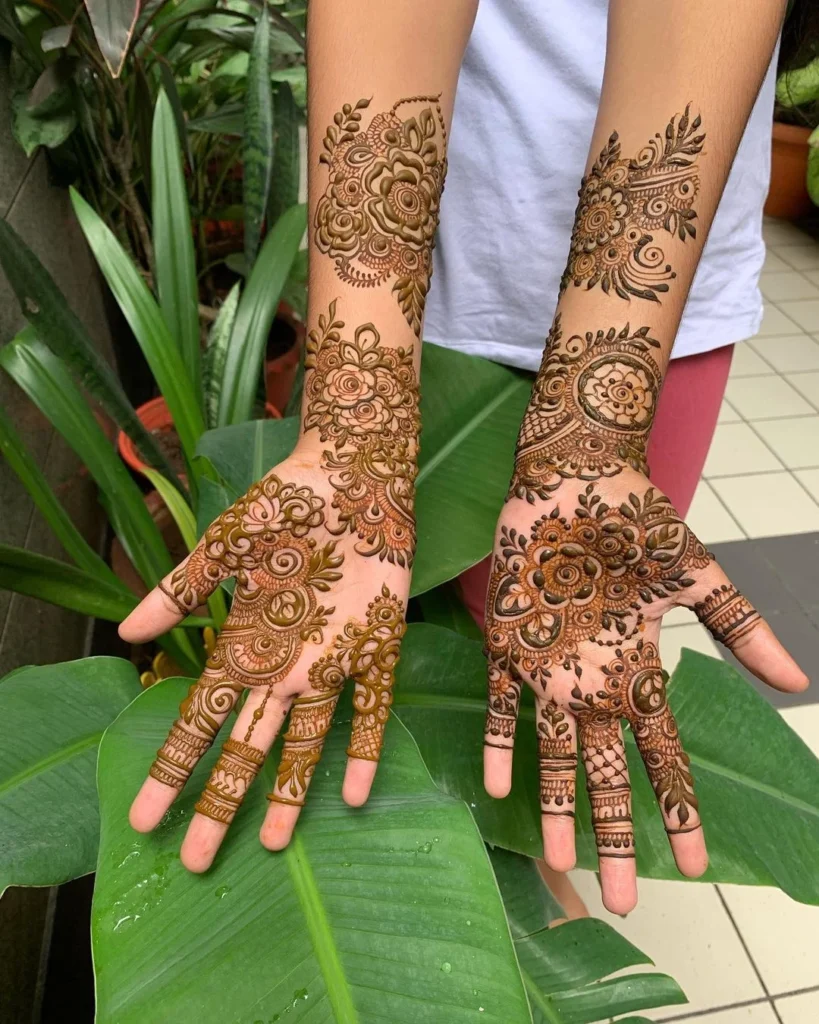
1. Traditional Beginnings: Simple and Symbolic Designs
- प्राचीन प्रथाएँ: दक्षिण एशिया में मेहंदी का उपयोग प्राचीन काल से होता आ रहा है, जिसकी शुरुआती जड़ें मिस्र और भारतीय सभ्यता में पाई जाती हैं। राखी मेहंदी डिज़ाइनों के शुरुआती दौर में मेहंदी साधारण और प्रतीकात्मक आकृतियों में लगाई जाती थी, जिनमें प्रायः फूलों की आकृतियाँ, पेसली (अंबी डिज़ाइन) या सरल ज्यामितीय आकार शामिल होते थे। इन डिज़ाइनों का उद्देश्य समृद्धि, शुभ भाग्य और सुरक्षा का प्रतीक होना था।
- राखी में भूमिका: शुरुआती समय में, राखी के उत्सव को मनाने के लिए मेहंदी मुख्य रूप से महिलाओं द्वारा लगाई जाती थी। यह तैयारी की एक रस्म मानी जाती थी, खासकर बहनों के लिए, जो राखी बांधने से पहले खुद को सजाने के लिए मेहंदी रचाती थीं। डिज़ाइन भले ही साधारण होते थे, लेकिन वे गहरे प्रतीकात्मक अर्थ रखते थे और प्रायः पवित्र आकृतियाँ जैसे स्वस्तिक या पुष्प डिज़ाइन शामिल होते थे, जिन्हें आशीर्वाद और सुरक्षा प्रदान करने वाला माना जाता था।
2. Classic Indian Mehndi Styles: From Hands to Feet
- पारंपरिक मेहंदी का उपयोग: 20वीं शताब्दी की शुरुआत तक भारत में मेहंदी का उपयोग और भी व्यापक हो गया, जिसमें अधिक जटिल और बारीक डिज़ाइन शामिल होने लगे। मेहंदी केवल हाथों तक सीमित नहीं रही, बल्कि इसे पैरों और यहाँ तक कि बाजुओं (फोरआर्म्स) पर भी लगाया जाने लगा। डिज़ाइन अधिक विस्तृत हो गए, जिनमें पतली रेखाएँ, पैटर्न और घुमावदार आकृतियाँ शामिल होती थीं।
- राखी और मेहंदी एक अनुष्ठान के रूप में: राखी में मेहंदी की भूमिका अब और भी अनुष्ठानिक महत्व लेने लगी। यह केवल सजावट भर नहीं रही, बल्कि एक आध्यात्मिक और सांस्कृतिक परंपरा बन गई। विशेष रूप से बहनें इस अवसर पर अपने हाथों पर मेहंदी लगाती थीं, क्योंकि इसे अपने भाइयों के लिए प्रेम और सुरक्षा के बंधन का प्रतीक माना जाता था।
3. Post-Independence Era: Flourishing of Mehndi Art
- सांस्कृतिक पुनर्जागरण: 1947 में भारत की आज़ादी के बाद, मेहंदी कला को राष्ट्र की सांस्कृतिक धरोहर के रूप में नया जीवन मिला। 1950 और 1960 के दशक में त्योहारों, विशेषकर रक्षाबंधन मेहंदी डिज़ाइनों में इसका उपयोग और भी बढ़ गया। इस समय मेहंदी कलाकारों ने नई तकनीकें और डिज़ाइन अपनाने शुरू किए।
सांस्कृतिक प्रभाव: इस दौर में पारंपरिक डिज़ाइन अन्य संस्कृतियों के प्रभाव से मिश्रित होकर नए और नवोन्मेषी पैटर्न बनाने लगे। मेहंदी का संबंध अब केवल राखी तक सीमित न रहकर शादियों, त्योहारों और अन्य समारोहों से भी जोड़ा जाने लगा। इसने रक्षाबंधन में अपनी जगह को एक सांस्कृतिक परंपरा के रूप में और भी मजबूत कर लिया।
क्या आप चाहेंगे कि मैं अब इसका अगला हिस्सा भी अनुवाद कर दूँ—जैसे आधुनिक दौर (सोशल मीडिया और ग्लोबलाइजेशन) का प्रभाव रक्षाबंधन मेहंदी पर?
4. The 1990s: Modernization and Commercialization
- वैश्विक प्रभाव: 1990 के दशक में मेहंदी कला का वैश्वीकरण शुरू हुआ। जैसे-जैसे भारतीय संस्कृति पूरी दुनिया में फैली, हिना (मेहंदी) दक्षिण एशिया से बाहर भी लोकप्रिय होने लगी। शहरी क्षेत्रों में रक्षाबंधन उत्सव के दौरान अधिक आधुनिक डिज़ाइन अपनाए जाने लगे। मेहंदी कलाकारों ने अपने काम में पश्चिमी शैली जैसे बोल्ड पैटर्न, ट्राइबल डिज़ाइन और समकालीन मोटिफ़ शामिल करने शुरू कर दिए।
- मेहंदी किट्स और स्टेंसिल्स: इस दौर में रेडीमेड मेहंदी किट्स, पहले से बने स्टेंसिल्स और सुविधाजनक मेहंदी कोन उपलब्ध होने लगे, जिससे लोग आसानी से घर पर ही मेहंदी लगा सकते थे। अब पारंपरिक मेहंदी कलाकारों पर निर्भरता कम हो गई। इससे खासकर युवा पीढ़ी के बीच रक्षाबंधन पर मेहंदी लगाने की परंपरा और भी सुलभ और लोकप्रिय हो गई।
5. Early 2000s: Fusion and Innovation
- फ़्यूज़न स्टाइल्स: साल 2000 के दशक में पारंपरिक भारतीय डिज़ाइनों और आधुनिक वैश्विक प्रभावों का एक बड़ा मेल (फ़्यूज़न) देखने को मिला। डिज़ाइनर्स ने बोल्ड ज्यामितीय आकृतियों, पुष्प अरबेस्क और अमूर्त पैटर्नों के साथ प्रयोग करना शुरू किया। इसी समय रंगीन मेहंदी (लाल, काली, सफेद आदि) का भी चलन शुरू हुआ, जिससे डिज़ाइनों में और अधिक विविधता आ गई।
- फ़ैशन के रूप में मेहंदी: इस दौरान मेहंदी को एक फ़ैशन स्टेटमेंट के रूप में देखा जाने लगा। कुछ कलाकारों ने डिज़ाइनों में ग्लिटर और रत्न (जेमस्टोन्स) तक शामिल करना शुरू कर दिया, जिससे वे गहनों जैसे दिखने लगे। रक्षाबंधन के उत्सव में भी इन फ़ैशनेबल डिज़ाइनों को अपनाया जाने लगा, ताकि इस अवसर पर पारंपरिक तत्वों से आगे बढ़कर अतिरिक्त आकर्षण जोड़ा जा सके।
6. 2010s: Digital Era and Social Media Influence
- डिजिटल और ऑनलाइन प्रभाव: सोशल मीडिया प्लेटफ़ॉर्म जैसे इंस्टाग्राम और पिनटेरेस्ट के उदय के साथ, रक्षाबंधन पर मेहंदी कला ने एक बार फिर नया रूप ले लिया। युवा लड़कियाँ और महिलाएँ अपनी मेहंदी डिज़ाइन ऑनलाइन साझा करने लगीं, जिससे एक ट्रेंड कल्चर विकसित हुआ जो पूरी तरह से विज़ुअल सौंदर्य से प्रभावित था।
- सेलिब्रिटी प्रभाव: बॉलीवुड सितारों और अंतरराष्ट्रीय हस्तियों को जटिल मेहंदी डिज़ाइन पहने हुए देखा गया, जिससे सेलिब्रिटी-प्रेरित और डिज़ाइनर मेहंदी स्टाइल्स की मांग में तेजी आई। रक्षाबंधन का उत्सव युवा महिलाओं के लिए अपनी रचनात्मकता दिखाने और मेहंदी डिज़ाइन ट्रेंड में भाग लेने का अवसर बन गया।
7. Current Trends: Mehndi as a Form of Expression
- व्यक्तिगत और कस्टम डिज़ाइन: आज रक्षाबंधन पर मेहंदी कला पहले से कहीं अधिक व्यक्तिगत (Personalized) हो गई है। आधुनिक कलाकार अब ऐसे डिज़ाइन बनाते हैं जो व्यक्ति की निजी शैली और त्यौहार के साथ उसकी भावनात्मक जुड़ाव को दर्शाते हैं। नाम, अक्षरों (initials) या भाई-बहन के रिश्ते के विशेष प्रतीकों वाली कस्टम मेहंदी आजकल काफी लोकप्रिय हैं।
- एकजुटता का प्रतीक के रूप में मेहंदी: पिछले कुछ वर्षों में, कई लोग संस्कृति की परवाह किए बिना रक्षाबंधन पर भाई-बहन के रिश्ते का उत्सव मनाने के लिए मेहंदी का उपयोग करते हैं। मेहंदी कार्यशालाएँ (workshops) आम हो गई हैं, जहाँ हर उम्र के लोग एक साथ इकट्ठा होकर मेहंदी लगाने की कला सीखते और अभ्यास करते हैं। इस तरह मेहंदी एक सामुदायिक गतिविधि के रूप में अपनी भूमिका को और मजबूत करती है।
8. Sustainability and Ethical Considerations
- प्राकृतिक मेहंदी: जैसे-जैसे रसायन-मुक्त (chemical-free) उत्पादों की मांग बढ़ रही है, रक्षाबंधन के अवसर पर प्राकृतिक और ऑर्गेनिक मेहंदी की ओर लोगों का रुझान फिर से बढ़ गया है। अब ध्यान सस्टेनेबिलिटी (sustainability) पर है, और कई लोग ताज़ा पिसा हुआ मेहंदी पाउडर और बिना रसायन वाले कोन का उपयोग करना पसंद करते हैं।
- पर्यावरण-हितैषी रुझान: ऑर्गेनिक मेहंदी के साथ-साथ अब मेहंदी उत्पादों के लिए पर्यावरण-हितैषी पैकेजिंग पर भी जोर दिया जा रहा है। यह रुझान समाज में बढ़ती पर्यावरण जागरूकता को दर्शाता है।
रक्षाबंधन मेहंदी डिज़ाइनों में मेहंदी कला का विकास परंपरा और आधुनिकता का एक अनोखा संगम है, जिसमें डिज़ाइन लगातार बदलते समय, संस्कृति, फैशन और तकनीक के प्रभाव को दर्शाते हैं। साधारण फूलों के पैटर्न से लेकर जटिल, व्यक्तिगत डिज़ाइनों और सोशल मीडिया के प्रभाव तक, मेहंदी हमेशा से रक्षाबंधन का एक अविनाशी और प्रिय हिस्सा रही है।
आज भी मेहंदी भाई-बहन के अटूट रिश्ते को मनाने का एक सुंदर और प्रतीकात्मक तरीका है, जहाँ हर बारीक स्ट्रोक में कला, संस्कृति और परंपरा का मेल दिखाई देता है।
Cultural Significance of Mehndi in Rakhi Festival
मेहंदी (हिना) का दक्षिण एशिया के कई त्यौहारों में विशेष सांस्कृतिक महत्व है, विशेषकर राखी के अवसर पर। राखी भारत में मुख्य रूप से मनाया जाने वाला एक पारंपरिक पर्व है, जिसमें बहनें अपने भाइयों की कलाई पर राखी (सुरक्षात्मक धागा) बांधती हैं, जो प्यार, सुरक्षा और आजीवन बंधन का प्रतीक होता है।
राखी के उत्सव में मेहंदी की अहम भूमिका होती है और इसका सांस्कृतिक महत्व इस प्रकार है:
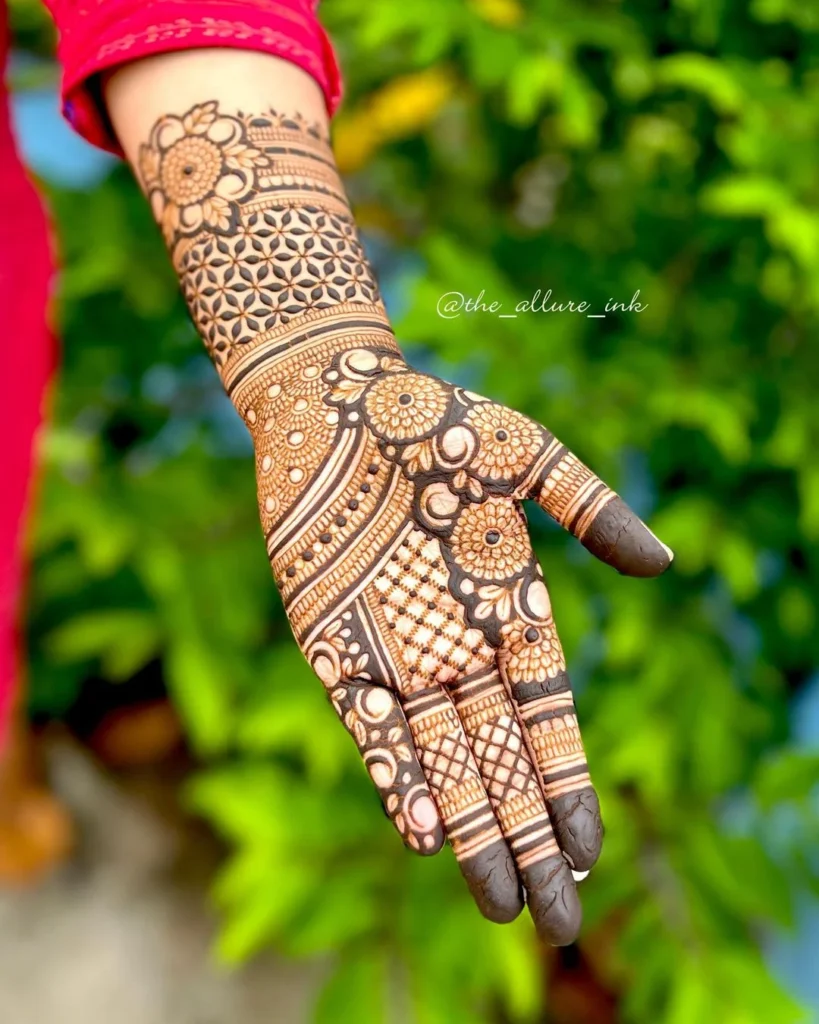
1. Symbol of Prosperity and Happiness
- आशीर्वाद के रूप में मेहंदी: राखी के संदर्भ में हाथों पर मेहंदी लगाना आशीर्वाद माना जाता है। इसके सुंदर और जटिल डिज़ाइन सुख-समृद्धि, आनंद और उज्ज्वल भविष्य का प्रतीक होते हैं। यह भी माना जाता है कि मेहंदी का रंग जितना गहरा होता है, भाई-बहन का बंधन उतना ही मजबूत होता है और यह प्रेम तथा सौभाग्य का संकेत माना जाता है।
2. Cultural Tradition and Ritual
- राखी से पहले के रीति-रिवाज़: राखी समारोह से पहले महिलाओं, विशेषकर बहनों के लिए, हाथों और पैरों पर मेहंदी लगाना एक परंपरा है। यह रीति-रिवाज़ दक्षिण एशियाई संस्कृति में गहराई से जुड़ा हुआ है और इसे त्योहार की तैयारी का एक महत्वपूर्ण हिस्सा माना जाता है। मेहंदी लगाने का यह कार्य अक्सर एक सामाजिक आयोजन का रूप ले लेता है, जहाँ परिवार के सदस्य और मित्र एक साथ मिलकर उत्सव की खुशी और उमंग को साझा करते हैं।
3. Artistic Expression
- जटिल डिज़ाइन: राखी के अवसर पर मेहंदी में सुंदर और बारीक डिज़ाइन बनाए जाते हैं, जो एकता और परंपरा का प्रतीक होते हैं। इन कलात्मक डिज़ाइनों में सांस्कृतिक धरोहर झलकती है, जिनमें प्रायः फूलों के पैटर्न, ज्यामितीय आकृतियाँ और शुभ प्रतीक शामिल होते हैं। मेहंदी लगाना व्यक्तिगत रचनात्मकता और कला कौशल को प्रदर्शित करने का भी एक अवसर होता है।
4. Celebration of Sisterhood
- रिश्तों को मजबूत बनाना: बहुतों के लिए राखी भाई-बहन के रिश्तों का उत्सव है, और मेहंदी इसे और भी खास बनाती है। बहनों या माताओं के हाथों में मेहंदी लगाने की प्रक्रिया परिवार की महिलाओं के बीच एक साझा बंधन को जन्म देती है। यह एक आत्मीय पल होता है, जहाँ महिलाएँ एक साथ आती हैं, अपने रिश्तों का जश्न मनाती हैं और परिवार में एकता की भावना को और मजबूत करती हैं।
5. Spiritual Significance
- आध्यात्मिक तत्व के रूप में मेहंदी: त्योहारों में, विशेषकर राखी के दौरान, मेहंदी लगाने को एक आध्यात्मिक अभिव्यक्ति भी माना जाता है। कहा जाता है कि यह सकारात्मक ऊर्जा को आमंत्रित करती है, नकारात्मकता को दूर करती है और उत्सव की सुंदरता में वृद्धि करती है। मेहंदी लगाने की यह शीतल प्रक्रिया व्यक्ति के मन और शरीर को शांति और सुकून प्रदान करती है।
6. Inclusion of Mehndi in Rakhi Celebrations
- एक मज़ेदार और उत्सवपूर्ण गतिविधि: अपनी सांकेतिक और आध्यात्मिक महत्ता से परे, राखी के दौरान मेहंदी लगाना एक मज़ेदार गतिविधि भी है, जिसमें परिवार एक साथ आकर उत्सव मनाते हैं। छोटी बहनें और चचेरी बहनें अक्सर साथ में मेहंदी लगवाती हैं, जो विशेष जुड़ाव का समय होता है और राखी की रस्म की गंभीरता में मस्ती का तत्त्व जोड़ता है।
7. Mehndi as a Social Tradition
- सामाजिक और पारिवारिक जुड़ाव: राखी पर्व में अपनी भूमिका के अलावा, मेहंदी सामाजिक जुड़ाव को बढ़ावा देने का भी एक माध्यम है। यह दोस्तों और परिवार के सदस्यों को एक साथ लाती है, जब वे मेहंदी लगाने और डिज़ाइन बनाने के अनुभव को साझा करते हैं। इससे समुदाय और एकता की भावना विकसित होती है, जो केवल निकट के परिवार तक सीमित नहीं रहती।
- राखी के दौरान मेहंदी केवल हाथों की सजावट नहीं है, बल्कि यह एक गहरी सांस्कृतिक परंपरा है जो प्रेम, सुरक्षा, समृद्धि और भाई-बहन के रिश्ते की मजबूती को दर्शाती है। यह एक कलात्मक अभिव्यक्ति, एक आध्यात्मिक क्रिया और पारिवारिक संबंधों को मजबूत करने का माध्यम है, जो इसे राखी के उत्सव का अभिन्न हिस्सा बनाता है।
Conclusion: Raksha Bandhan Mehndi Designs
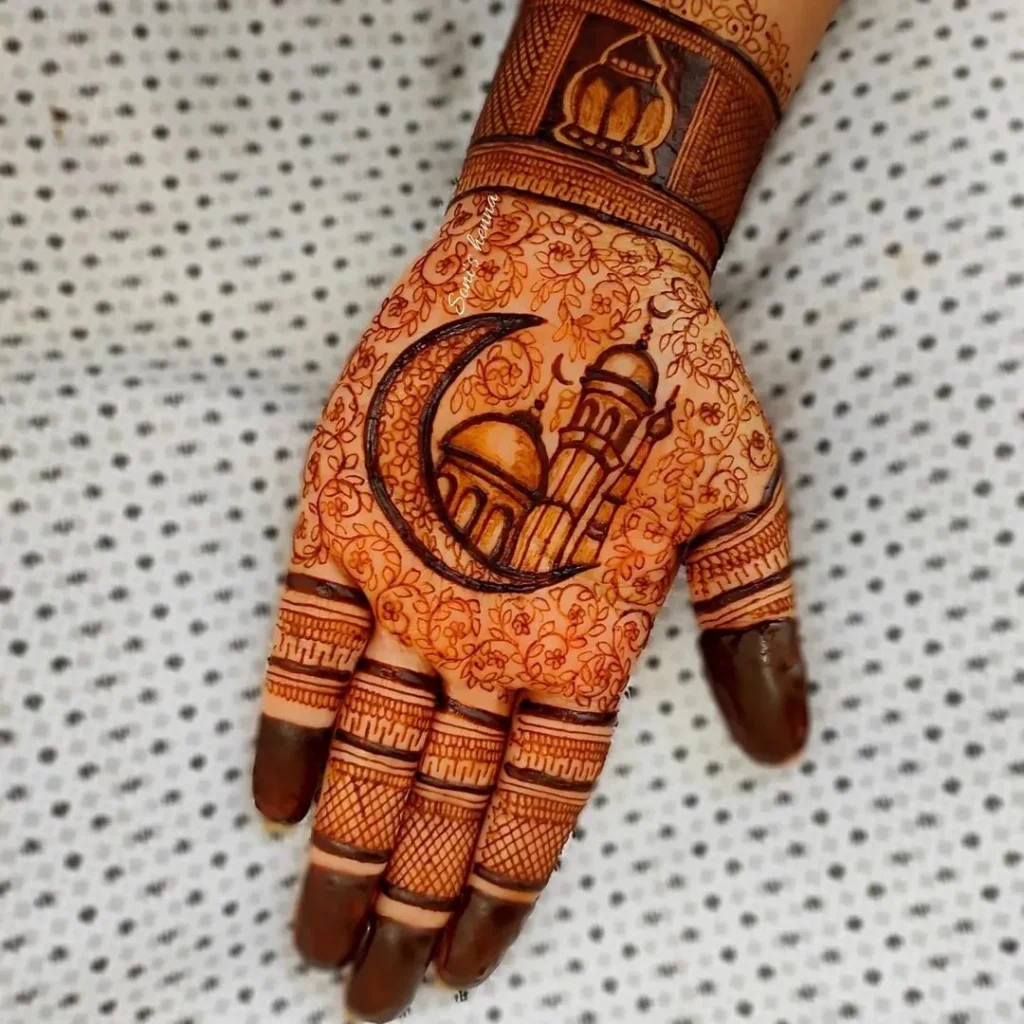
रक्षाबंधन मेहंदी डिज़ाइन इस त्योहार का एक अहम हिस्सा हैं, जो अवसर में सुंदरता, परंपरा और भावनाओं की एक नई परत जोड़ते हैं। ये डिज़ाइन, बारीक फूलों के पैटर्न से लेकर आधुनिक ज्यामितीय आकृतियों तक, केवल सजावट ही नहीं हैं—इनका गहरा सांस्कृतिक महत्व है और ये भाई-बहन के रिश्ते को और मजबूत बनाते हैं। रक्षाबंधन मेहंदी डिज़ाइन प्रेम, सुरक्षा और आशीर्वाद का प्रतीक हैं, जो भाई-बहन के रिश्ते को और भी खास बना देते हैं।
बहनों के लिए, रक्षाबंधन मेहंदी डिज़ाइन अपने भाइयों के प्रति स्नेह और शुभकामनाएँ व्यक्त करने का माध्यम हैं। मेहंदी लगाने की परंपरा एक ऐसा अनुष्ठान बन गई है जो बहनों और उनके प्रियजनों को साथ लाकर पारिवारिक रिश्तों को मजबूत करती है। भाइयों के लिए, बहन के हाथों पर सजी मेहंदी उनके साझा प्रेम और सुरक्षा के वादे का प्रतीक होती है।
जैसे-जैसे रक्षाबंधन मेहंदी डिज़ाइन विकसित हो रहे हैं, वे पारंपरिक कला और आधुनिक ट्रेंड्स का सुंदर मिश्रण बन गए हैं, जो हर व्यक्तित्व और पसंद के लिए अनेक विकल्प प्रदान करते हैं। चाहे पारंपरिक, आधुनिक या व्यक्तिगत (कस्टमाइज्ड) डिज़ाइन चुने जाएँ, मेहंदी रक्षाबंधन का अभिन्न हिस्सा बनी रहती है।
निष्कर्षतः, रक्षाबंधन मेहंदी डिज़ाइन इस त्योहार के हृदय में एक विशेष स्थान रखते हैं। ये न केवल अवसर को सुंदर बनाते हैं, बल्कि दिन के भावनात्मक और आध्यात्मिक महत्व को भी गहरा करते हैं। यह परंपरा सदाबहार है, जो भाई-बहन के रिश्ते को मजबूत करती है और इस हर्षोल्लास भरे त्योहार को यादगार बना देती है।
